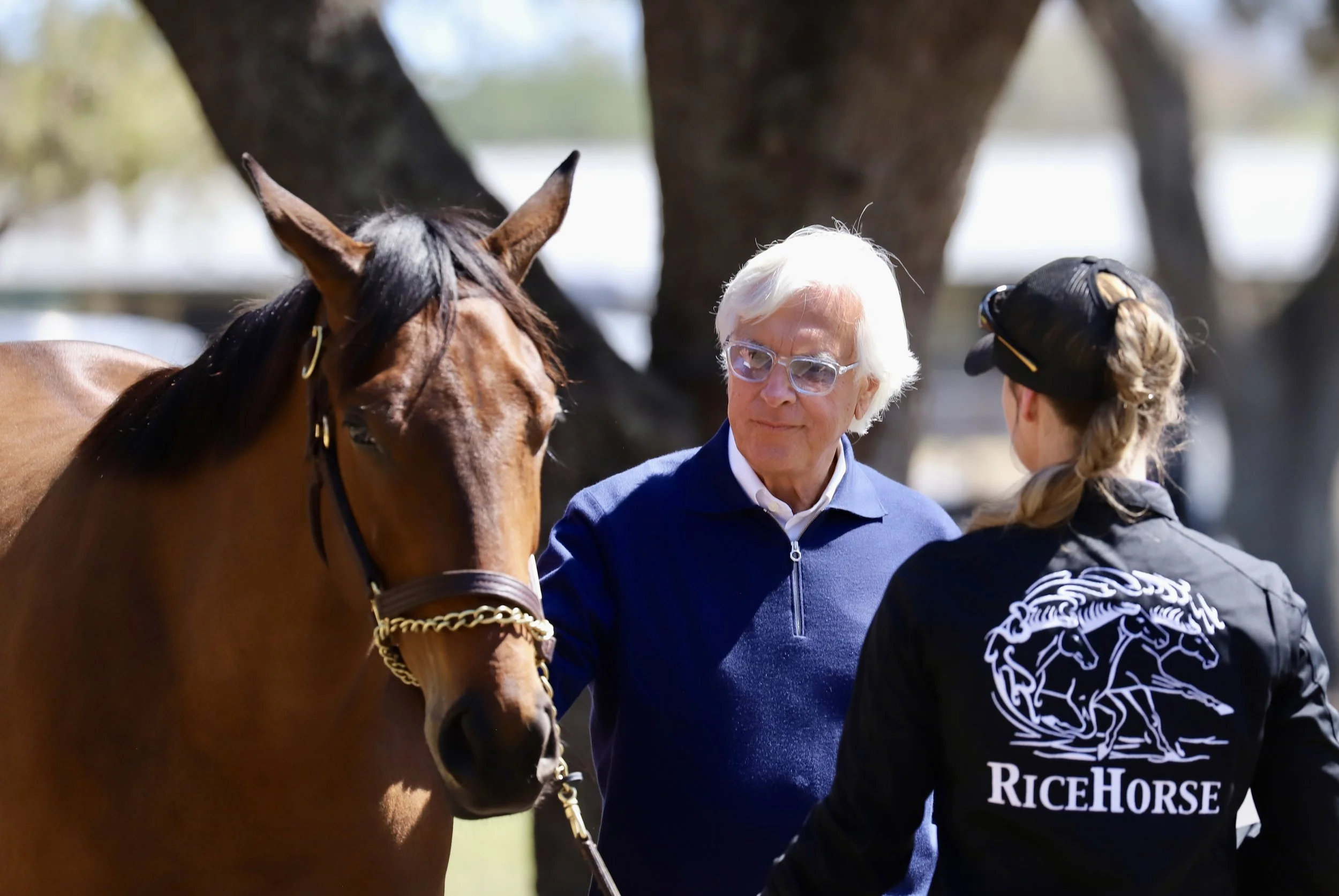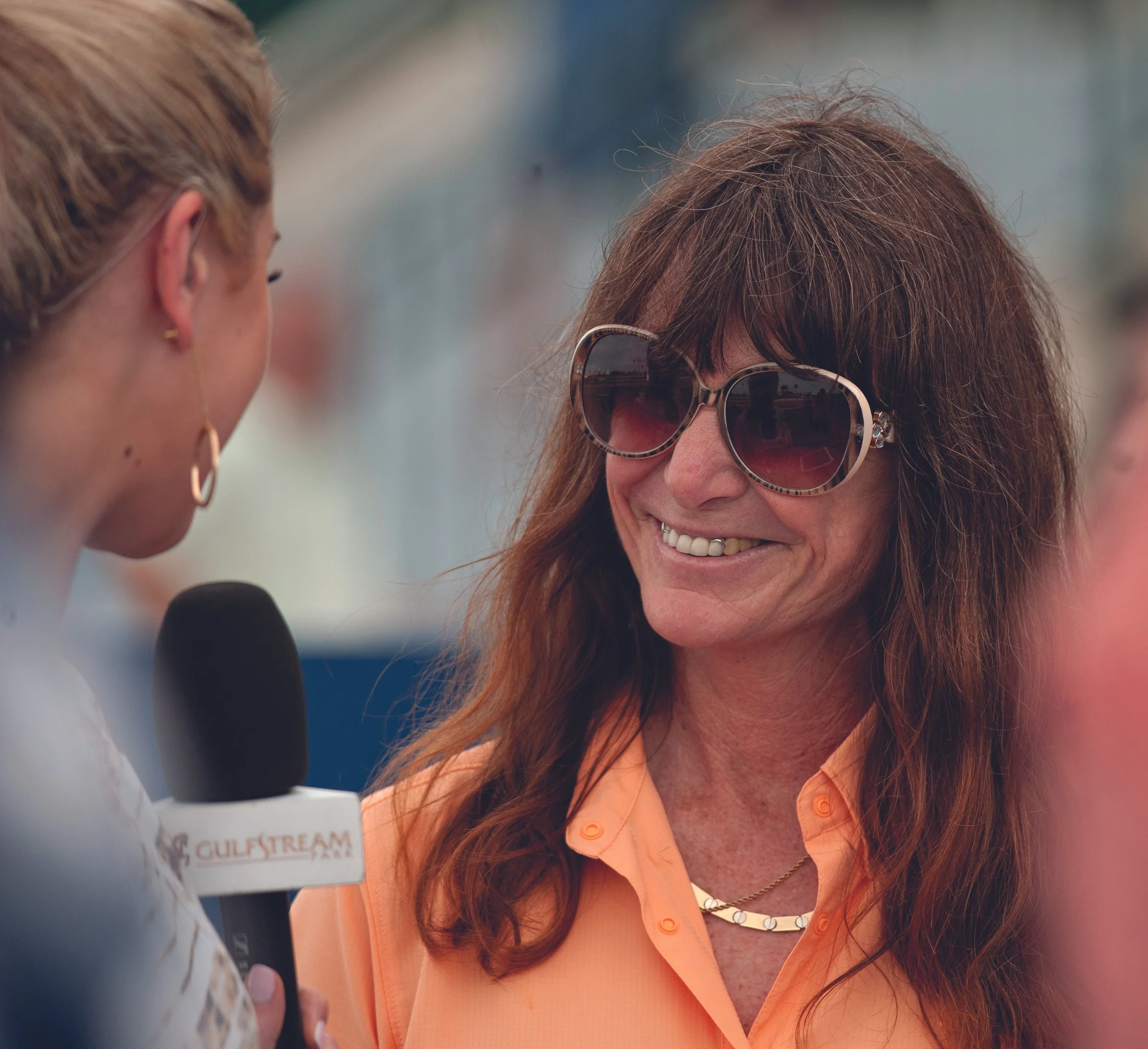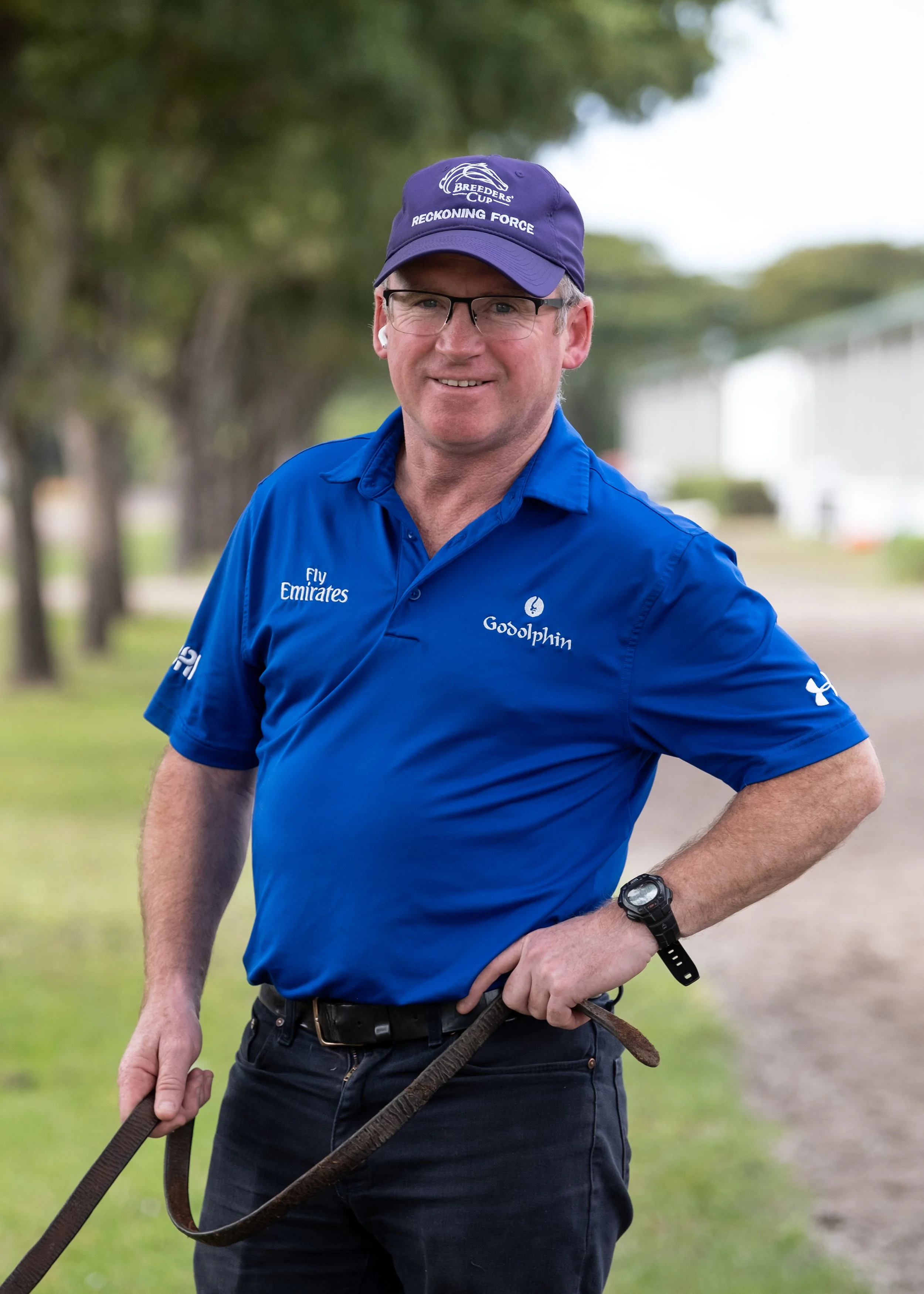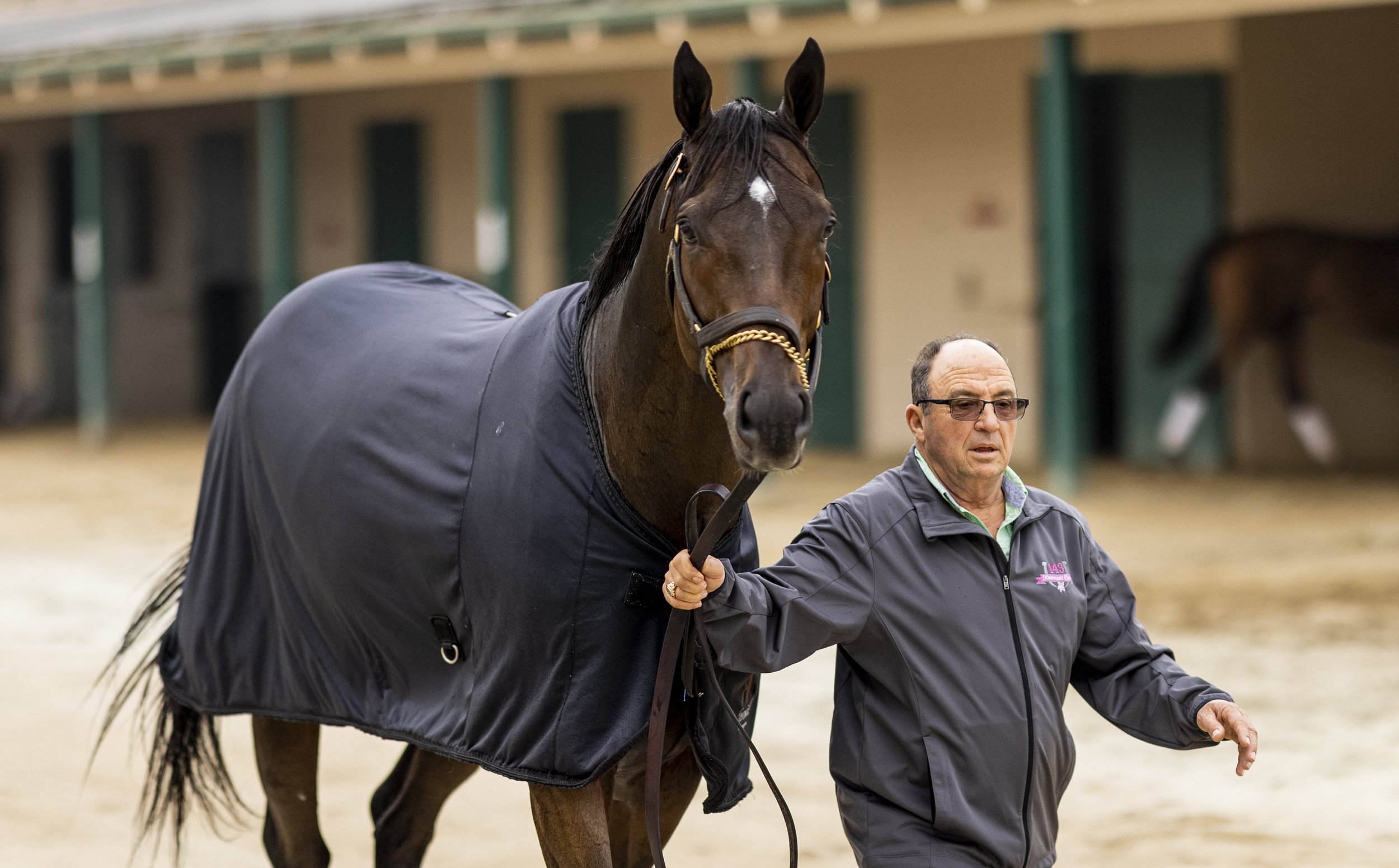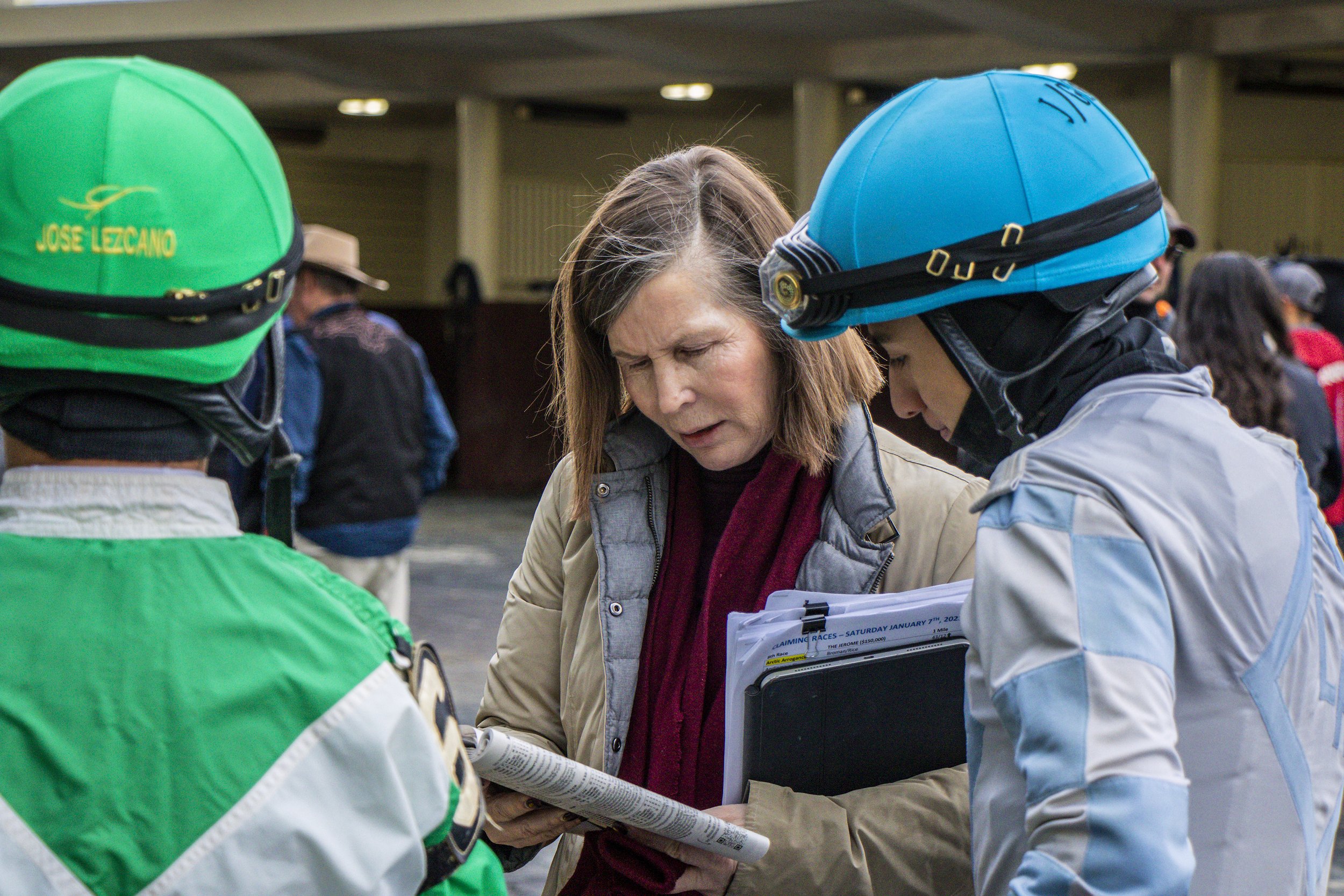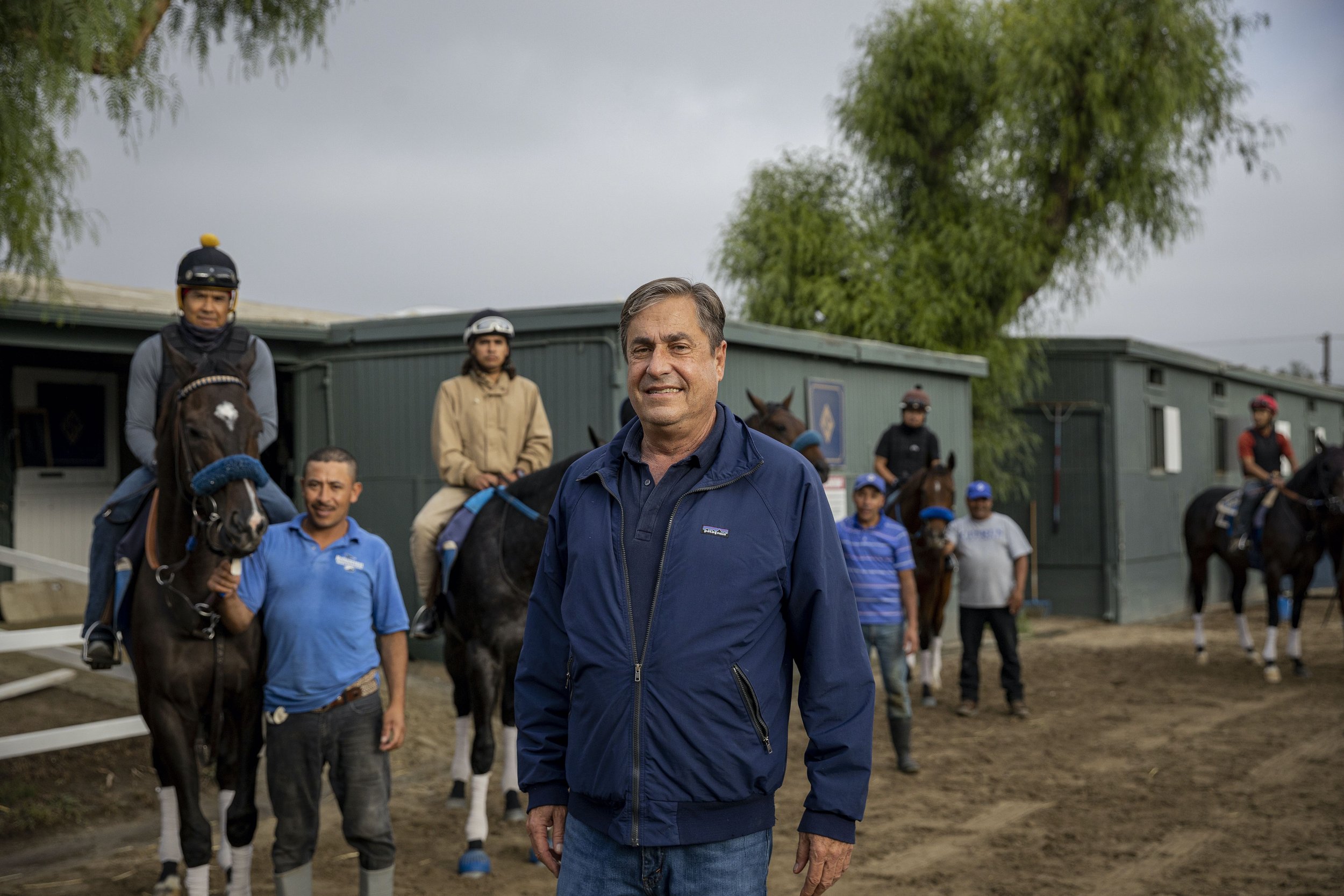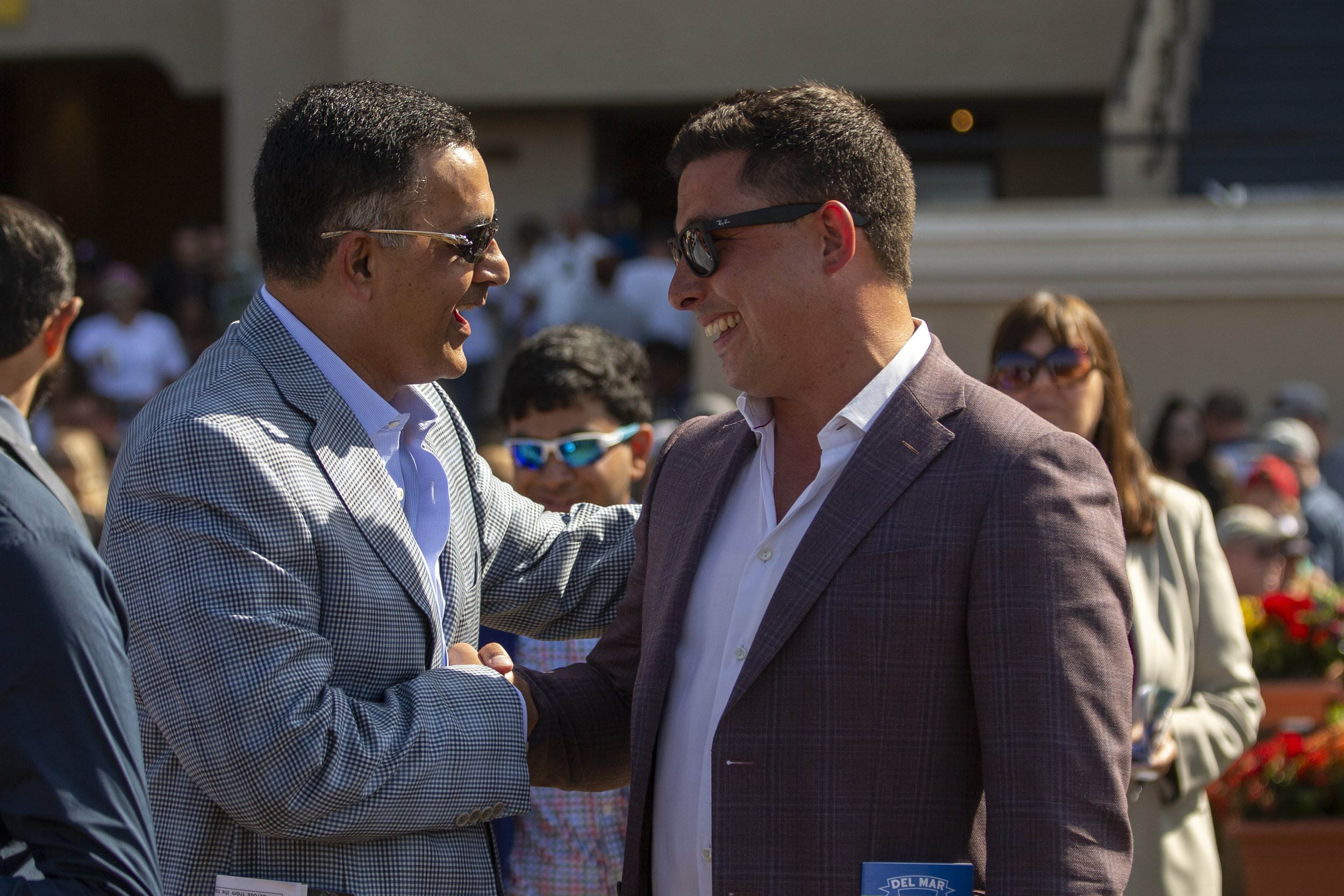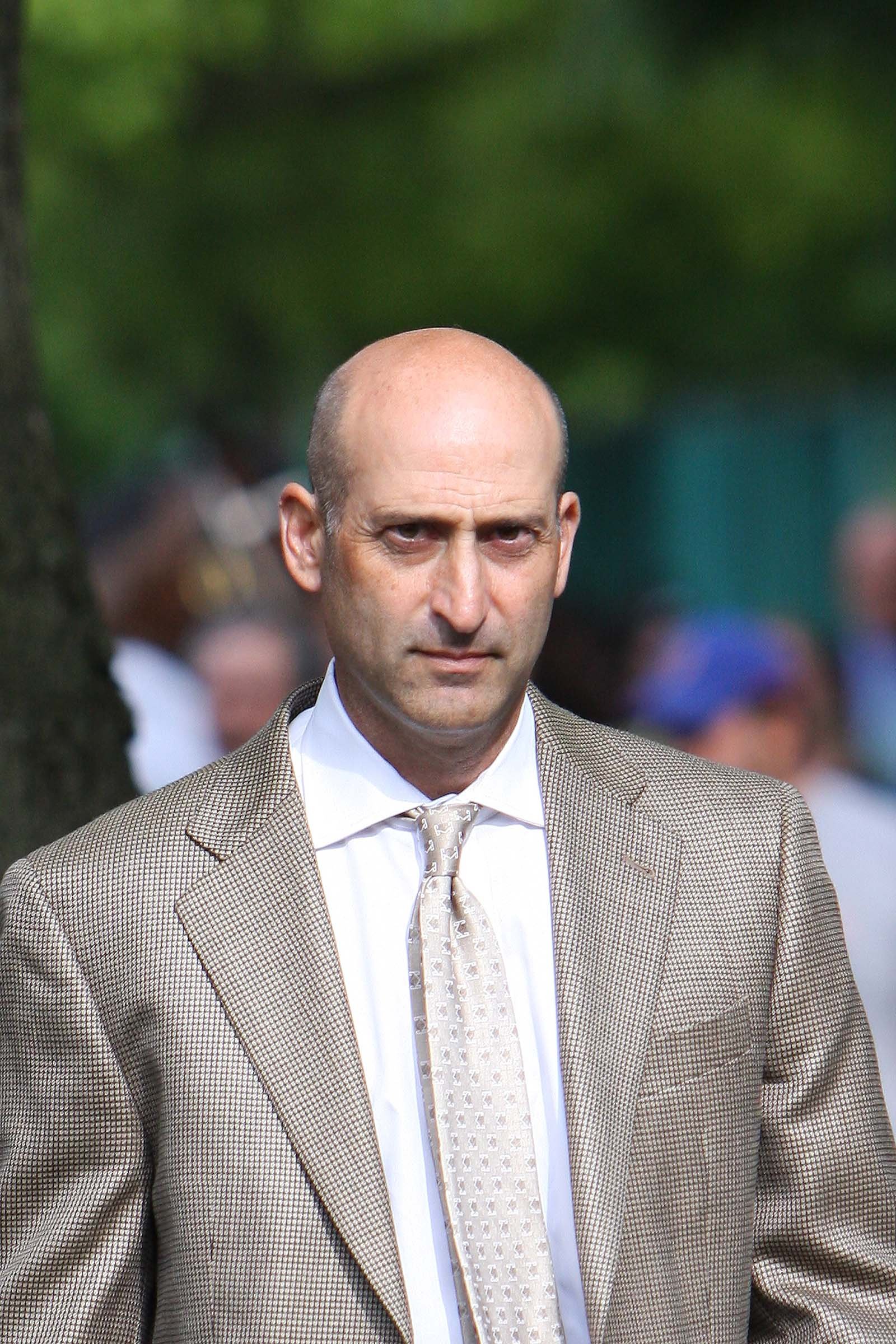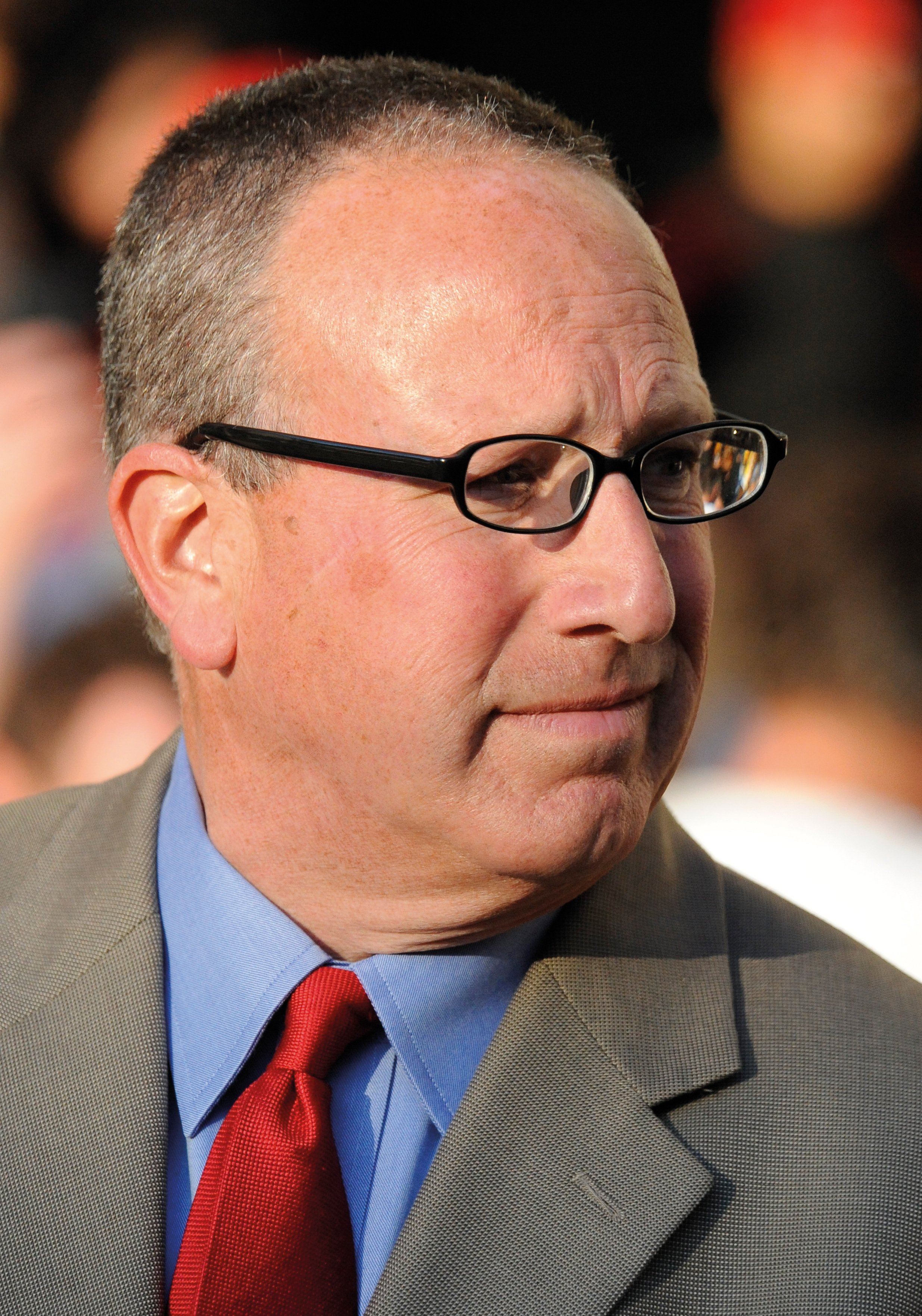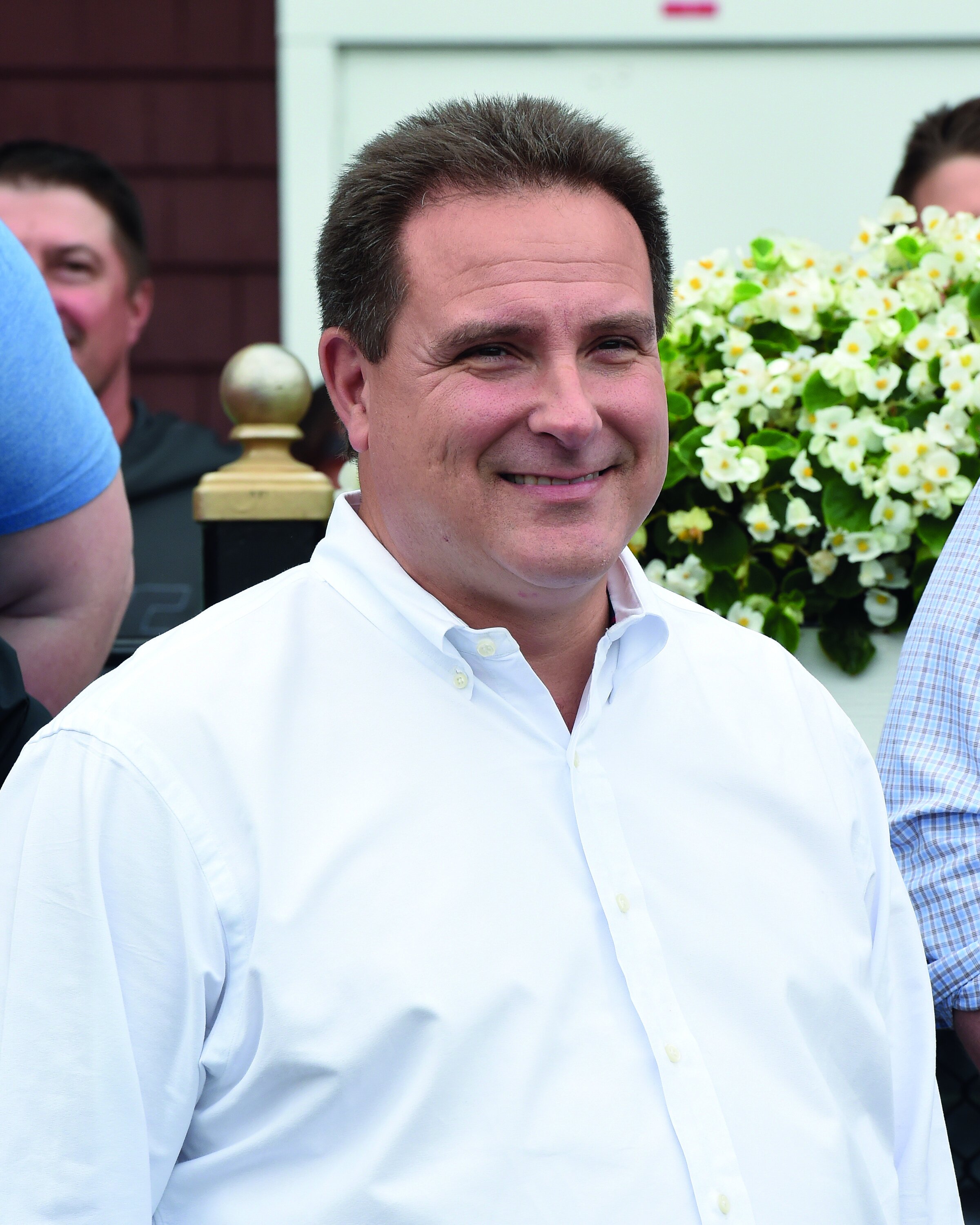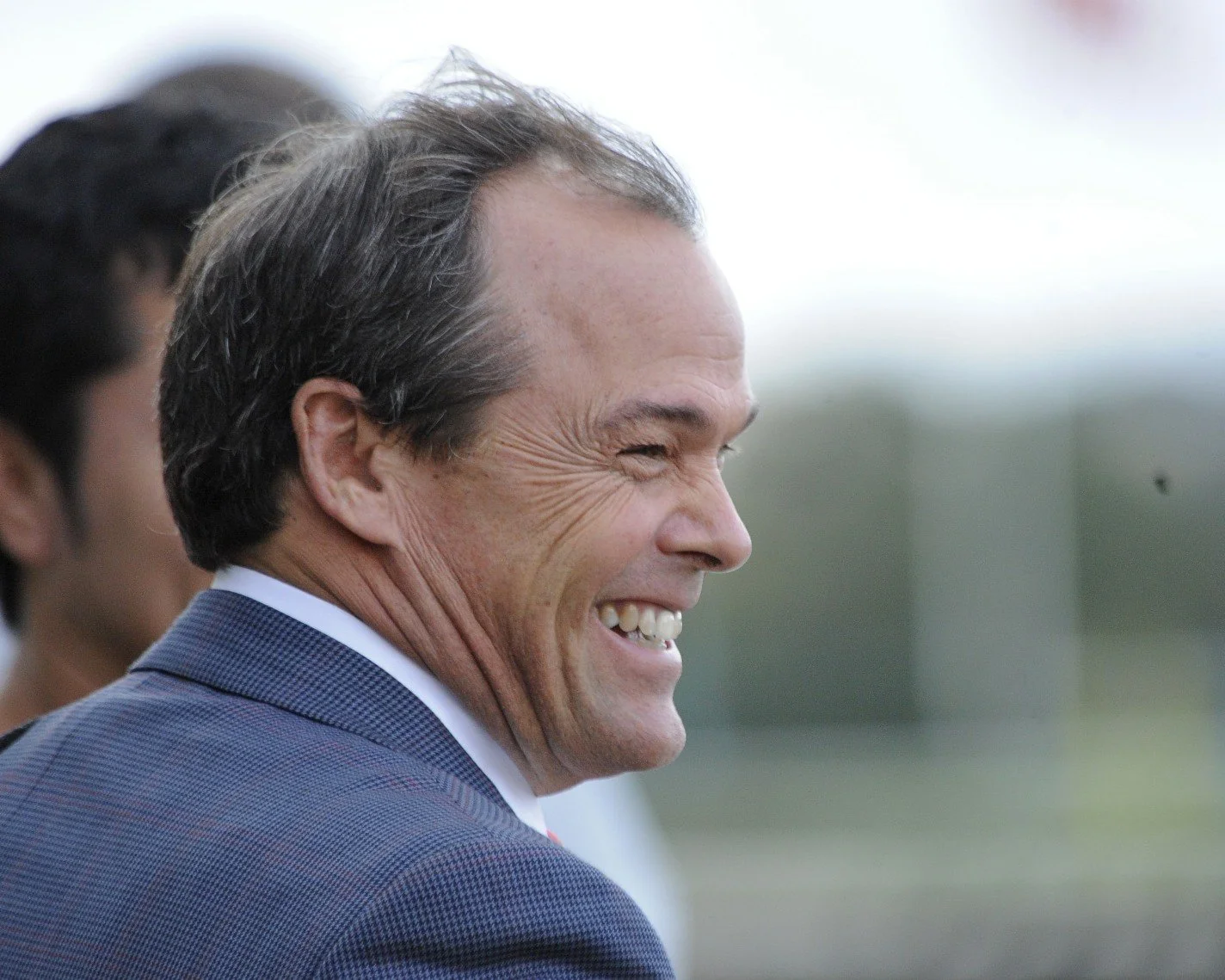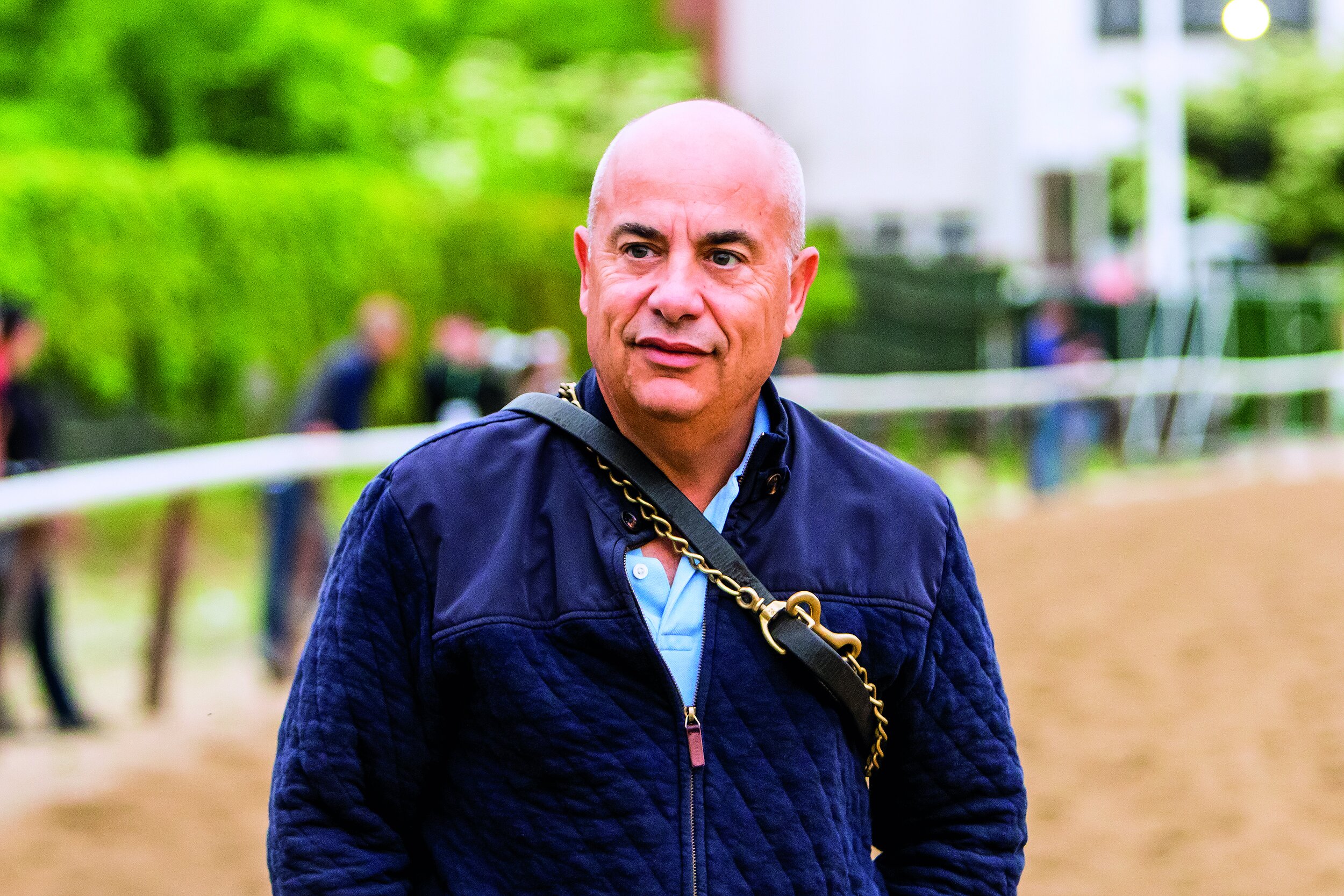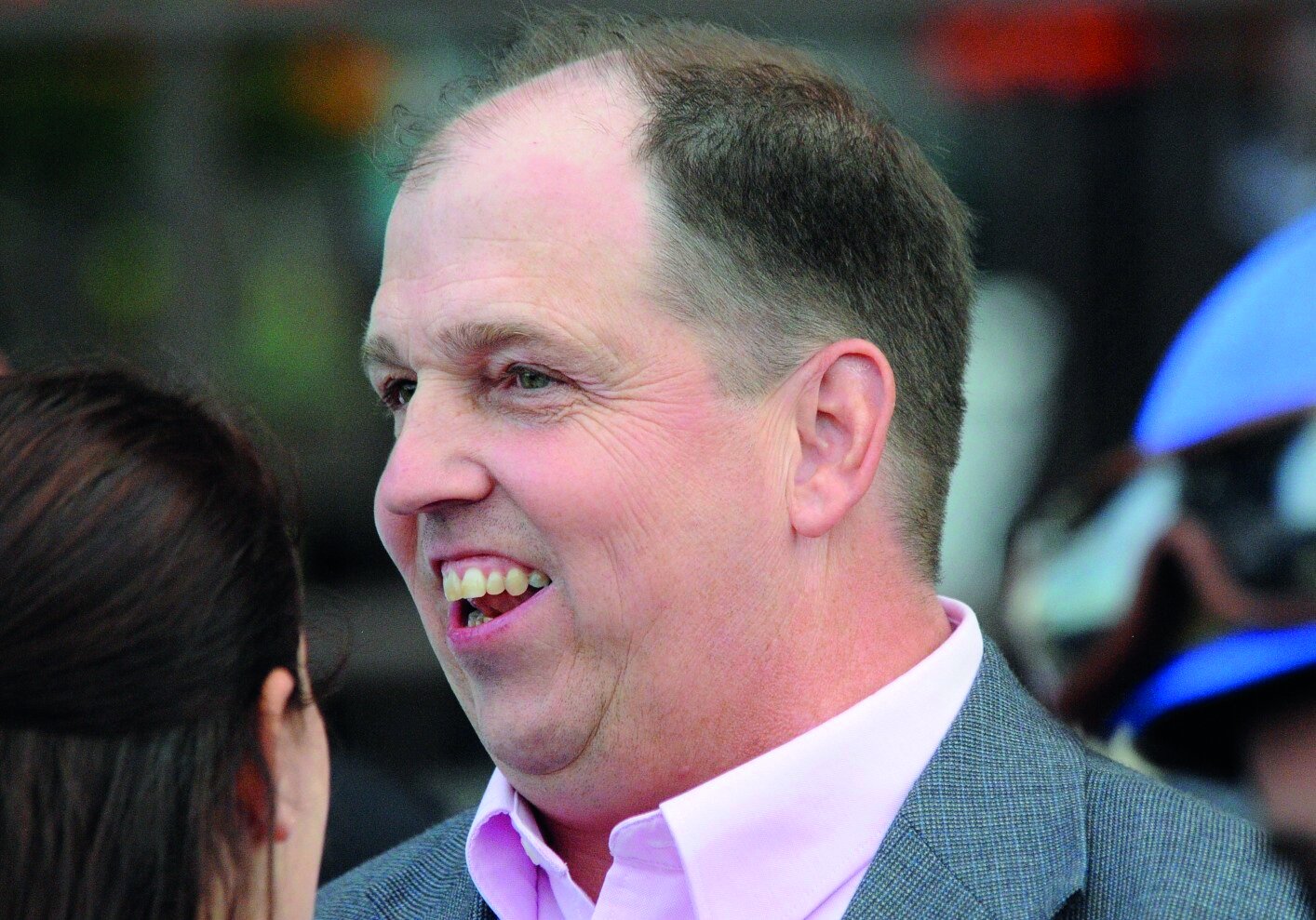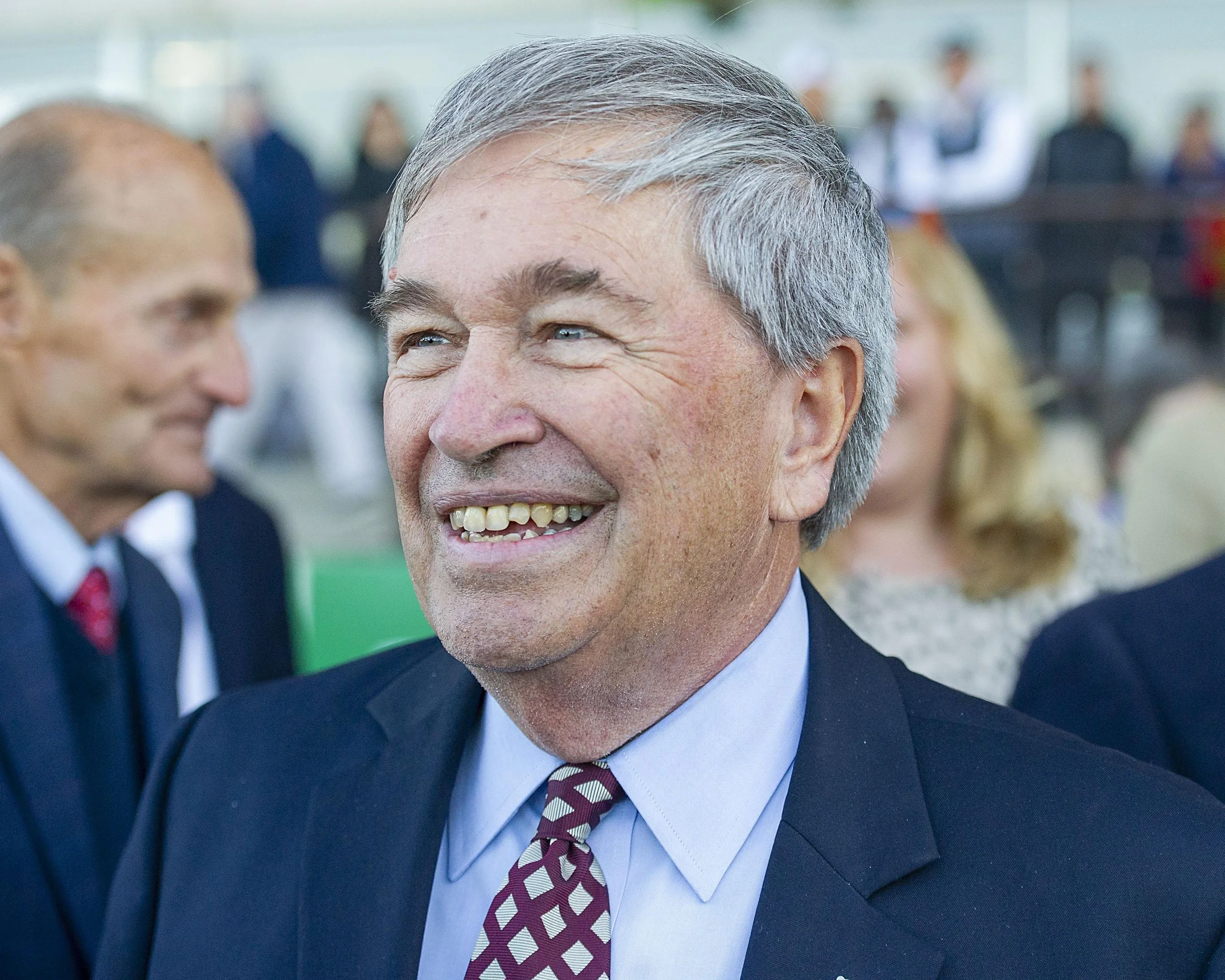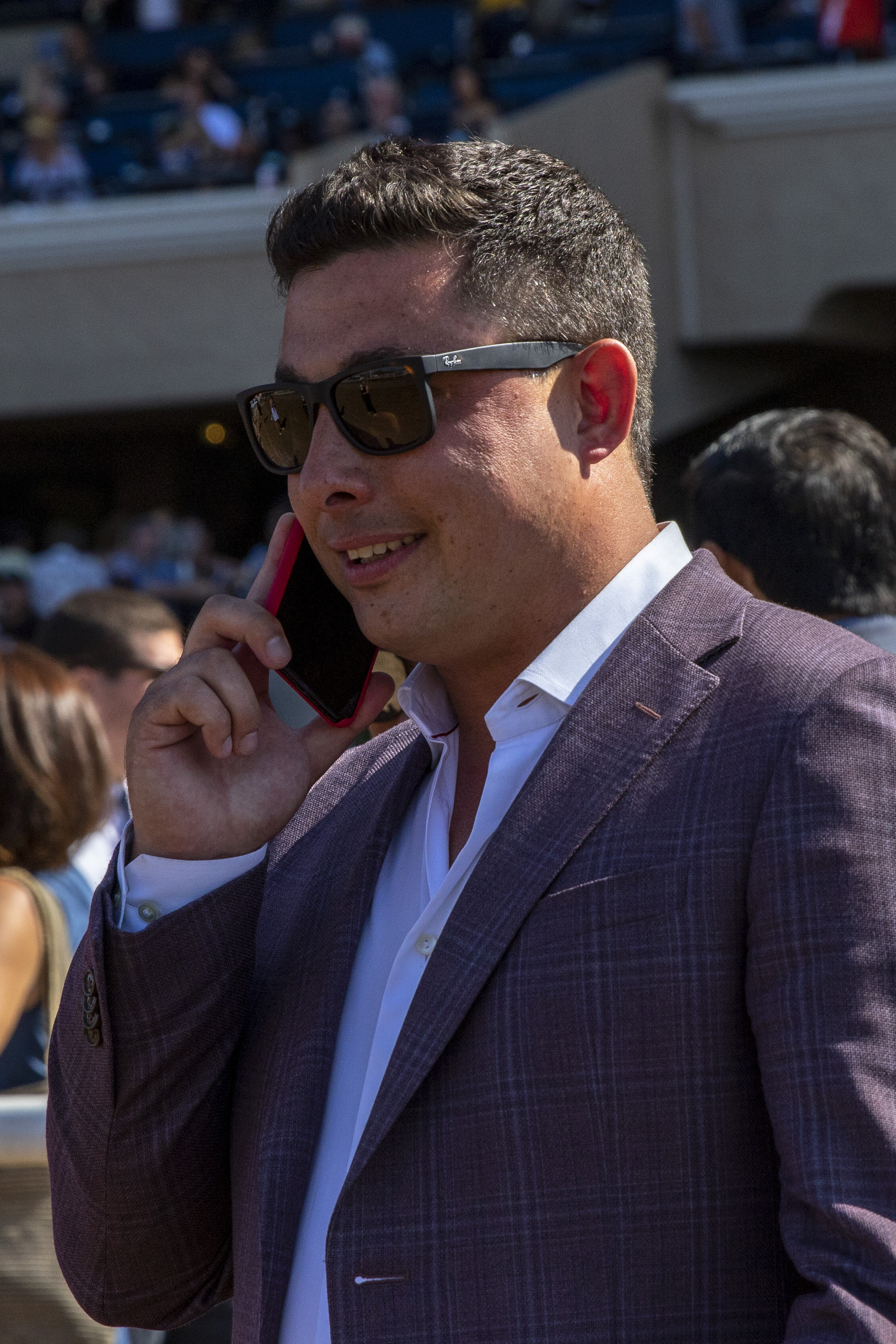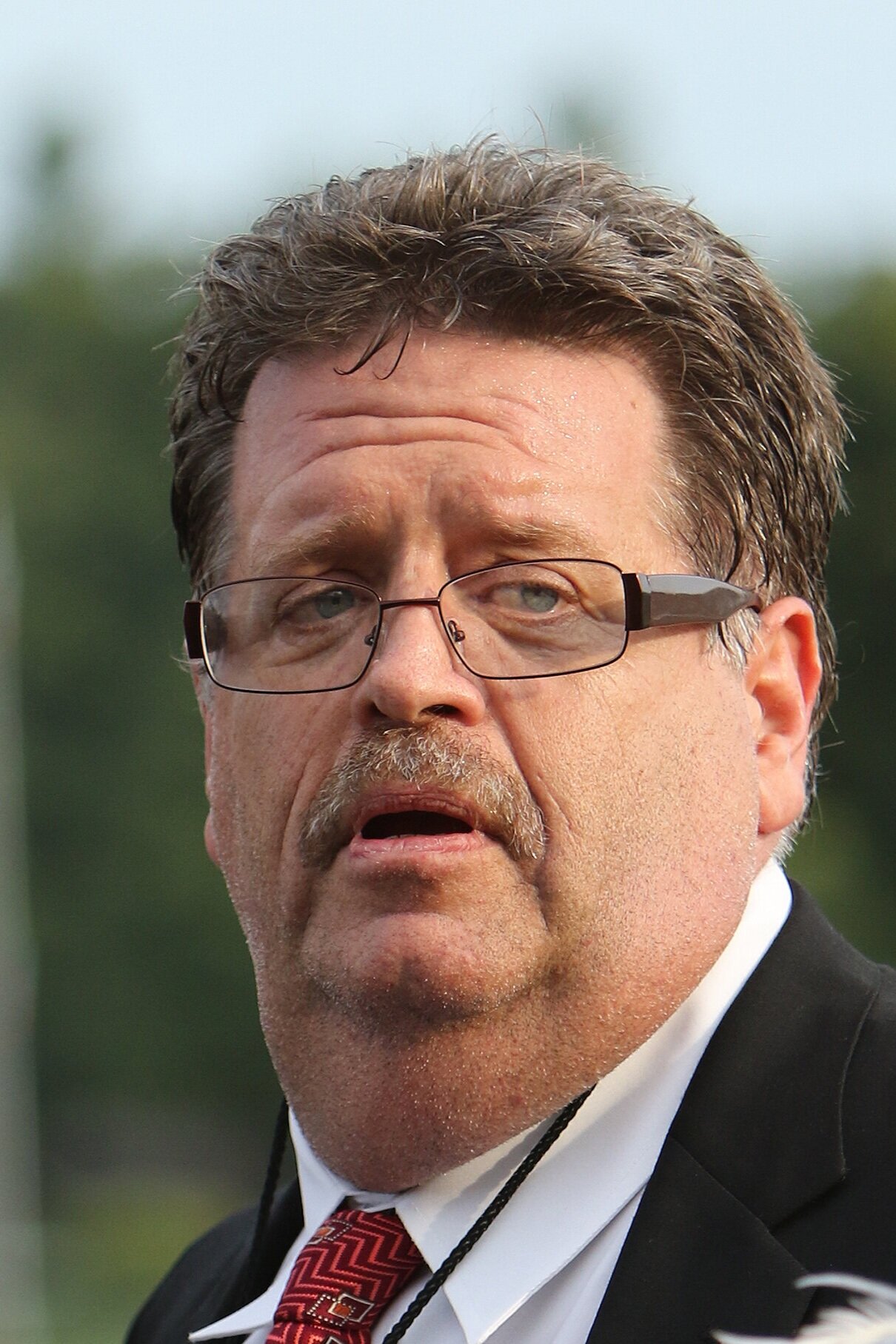#Soundbites - How much do the opinions of others affect your yearling evaluations?
Bob Baffert
The opinions of others cloud my decisions sometimes. I like to go in it myself, my initial reaction when I look at the horse myself. I base it on what I see in the horse. I try to keep the outside noise out. I’ve made some mistakes by listening to other people sometimes. At the end of the day, I go with what people call is a gut feeling. I call it experience of what worked for me and what didn’t work for me.
Bruce Levine
Everybody’s got an opinion on a yearling. One guy will look at a horse and like him. The next guy - he just doesn’t like him. I do a physical. If the vet doesn’t like him, it’s very rare I’ll go against the vet. If he says it’s a 10 percent risk, that’s something different. Then I’ll let the price determine it. But if he’s telling me, “Stay away,” I’m staying away.
Mike Trombetta
When I’m making yearling selections, truthfully, everybody looks for different things. For me, personally, I like to tune out background noise and try to make my own decisions. Because, at the end of the day, I want to be happy with what I’ve selected and not so much based on what other people have to say.
Al Stall
A lot of people have teams, including myself. If it’s a team member, I’m all ears. Otherwise, I don’t really pay too much attention. We’ve been doing it a long time. We end up agreeing most of the time, and if we don’t agree we just throw it out and move on to the next. It’s us three, me and Frank and Daphne Wooten from Camden, South Carolina. They break our yearlings. We’ve been doing it together for quite a while. We’ve gotten lucky. Lucky is a very important word with yearlings.
Kathleen O’Connell
Everything is useful information. That’s the way I look at it. If you get to the point where you’re considering buying a yearling and a vet is telling you it’s got a problem, you’d want to steer away from it. As far as anything else, you can look it up. I have a high regard for the people that handle the hose, that are around the horse. So they know if it’s a nervous horse or a horse that’s a little more mentally mature. To be honest with you, I value everybody’s opinion, and then you just have to draw your own conclusion.
Mike Stidham
We have certain people we work with, a team of about five of us. We’ve been going to Keeneland for 30 years or more and we’ve had some success there with the budget we have to spend. We’re pretty pleased with what we’ve accomplished over the years, so the opinion of others really doesn’t come into play.
Mark Hennig
If I don’t like the yearling, I don’t buy it. But there’s been times where I like the yearling and someone might point something out to me that makes me take a closer look and veer away from it. We’re always capable of having a second set of eyes or a third set of eyes. I rarely look at a horse by myself. We usually have a team, an agent, my wife and I. In some cases an owner wants to look at them, too. We do miss things.
Brendan Walsh
I think you’ve got to have your opinion on them. I have people I work with, obviously, or if you’re looking for a client, you have to take their opinions on board, too. I mean they do influence you depending on the circumstances, but at the end of the day you have to have your own opinion.
#Soundbites - Do three-year-old fillies deserve better treatment in the Triple Crown series?
Compiled by Bill Heller
Since 2013, when the Kentucky Derby began using a point system to determine who starts in the Run for the Roses, no filly has raced in the Derby. This year, only seven of the 373 three-year-olds nominated for the Triple Crown were fillies. Do three-year-old fillies deserve better treatment, either by making Kentucky Derby and Kentucky Oaks points interchangeable and/or by making a more meaningful and permanent filly Triple Crown?
Bret Calhoun
I think the only way they can get points is one of the prep races against the males. Honestly, I think it’s a fair enough system. In my mind, if they’re going to take them on in the Derby, they probably should have to be proven against some of them in their prep races.
Kevin Attard
I do think they should have the option to run in the Oaks or take on the boys. Obviously, it takes a very special filly to win that race. Having a Triple Crown for the fillies I think is a wonderful idea. A series for the fillies would be something of significance. In today’s age of social media, you can reach out to a broader audience. In Canada, they do have the Triple Tiara. It’s not the equivalent to the colts. It doesn’t get the attention of the real Triple Crown.
Ron Moquett
I would say make a more permanent and meaningful Filly Triple Crown. Or there could be a deal where you could give up your status as a filly and only run in the Derby preps to get your own points and make yourselves eligible for the Kentucky Derby. That’s fine. That’s good because you did it against the competition that you are required to meet. You can’t get Derby points by beating fillies to run against colts. But I think we should constantly be looking at things to evolve the sport and keep moving forward. In the end, you’ve got to remember the whole thing we’re trying to do is to breed a better horse. So every decision we make sincerely should be about showcasing the best of our breed.
Neil Drysdale
Interchangeable points don’t work because you can’t run colts against fillies, but I think fillies should be running in the Triple Crown, especially looking back in history. The point is if you’ve got a filly and you want to run a mile and a quarter (the Derby distance) instead of a mile and an eighth (the Oaks distance), you should be allowed to do that. My own opinion is that the point system seems to be quite arbitrary. The point system needs to be continually revised until they get it right.
Todd Fincher
Well, as long as they’re not transgender it’s okay (long laugh). I don’t think it’s against the fillies. If they want to run in the Derby, they just have to face the boys in the preps. The filly races are pretty lucrative. There’s so much money not only in the purses, but in winning a Grade 1 with a filly. So unless you think you’re a real monster, you just stay in your lane. If you think your filly is good enough, well, run with the boys.
Peter Eurton
Wow, that is a good question, because I’ve never really even thought about it. For me, I would think that they should have an opportunity, but then it’s going to keep out some of the colts. That would be the biggest issue.
Richard Mandella
The Oaks is a big purse, and it’s at a very high level. You kind of hate to have too many fillies in the Derby. Maybe there could be a committee, people from Kentucky, California, New York and two other places, that allows starters to get in the Derby as a special case.
#Soundbites - What advice have you given or would you give your assistant if he or she decides to go out on his or her own?
Article by Bill Heller
Tom Amoss
My assistant is probably going to do that within the next year, Kinnon LaRose. I sat down with Kinnon a number of times. The advice I’ve given him is twofold. As it pertains to clients, you have to communicate as much as you probably can. I email all my clients once a week and give an update on their horses. I’m readily accessible on the telephone, and if anybody calls and I don’t answer, I call right back. I think communication is the key to someone that’s starting out because you’re offering the client something a lot of the bigger trainers can’t possibly do, which is really managing their investment in the Thoroughbreds. The second piece of advice is that you have to constantly be tending your horses, not only in the barn but also as you’re planning races for them. You can’t not go out there on a daily basis. If you take days off it’s going to catch up to you.
D. Wayne Lukas
I would say the major thing is that they are ready to make a commitment, a complete and 100 percent commitment to the profession and what they want to accomplish because it’s a very difficult and demanding profession. So make sure that you’re ready for it.
Leonard Powell
First, don’t go on your own too early. Take plenty of time to learn from other people’s mistakes. Make sure you surround yourself with good people. That goes for staff and owners.
Chris Englehart
Be honest with owners. It’s a tough business. There are pressures with making payroll. Just be honest.
John Shirreffs
I would have to tell them as assistant to find a client that you’re going to train for who is committed to you as a trainer and as an individual and will not waver over X amount of years. Always have fun in racing. It makes everything just a little bit better.
Kenny McPeek
The key is finding good horses to train. Take care of every horse you get, but if you want to go to the next level, you’ve got to get better quality horses. The racetrack life is tough. It’s a lot of hard work, but it’s pretty cool when it all comes together.
Jim Bond
Listen to the horse. The horse will tell you everything. Patience is everything. Run them when they’re ready to run.
#Soundbites - How does the trainer responsibility rule affect you delegating authority to an assistant, exercise rider and/or groom?
By Bill Heller
Linda Rice
You do your best to control as many variables as possible, but, of course, with the trainer responsibility rules and HISA rules, and considering the environment that we are training under at different racetracks and training centers, there are a lot of moving parts. It definitely gives you cause for pause and reasons to worry, but these are the rules that we’ve lived under for a long time, and we do our best and hope everything goes the right way for us.
Jeremiah Englehart
Ultimately, it’s my responsibility. It’s under my name, I’m responsible whether I’m there or not. Communication is always very important in making sure that the people that work on your team understand exactly what you’re saying and what needs to be done and how to do it the right way. Follow the rules. Make sure we’re conforming to the rules that are up there for us. It’s my name on it, but you can’t do everything in the barn. So you have to delegate.
Michael Matz
You just have to be responsible for people’s mistakes when they do make a mistake. That sometimes can be a very difficult situation. Accidents do happen. Sometimes it gets lost in the translation when you’re telling them to do one thing and it just doesn’t get done the way you ask them to do it, whether it’s feeding the horse, whether it’s taking the horse to the races, whether it’s jogging the horse for the veterinarian. This is the hard part. You cannot be lax. You have to make sure that you get it done right. It makes it more difficult, that’s for sure.
Leonard Powell
At the end of the day, the responsibility is one hundred percent ours. You can delegate some, but you can’t delegate 100 percent. So It’s something that we are always aware of. You have to be extremely diligent with the people you’re working with. You have to be on top of it.
Peter Miller
Let me think about it. It depends on the size of your barn. If it’s a small barn, you can do everything yourself, but when you’re running a bigger barn, it’s impossible. So you have to delegate and trust, but at the same time, that can put you at risk. I understand the reasoning for the trainer insurer rule, but it’s unfair in so many instances.
Kelly Breen
I’ve been fortunate enough to have a lot of the same help and they know what the trainer responsibility rule is. In this modern world, you never know what your help is doing. Some of the contamination is eye-opening as to what could be happening to some trainers out there.
Allen Milligan
It just puts me at complete weakness. I try to tell everybody who works for me the same thing: concentrate on what’s going on and make sure something doesn’t happen. But mistakes happen. I’ll never forget at Churchill Downs on Derby Day about 15 years ago, one of the people walking down the backside decided to use one of my stalls for a bathroom. It was a lady in a dress. I caught her coming out of the stall and I said, “There’s a restroom right down there ma’am.” I’ve seen it all.
#Soundbites - What's the hardest aspect of training?
Christophe Clement
You’ve got to be kidding. The list would be too long and you will not have enough room to cover it in one page. You’ve got to find the talent; you’ve got to find the help; you have to keep your owners happy; you have to find the right races. The list is endless. It’s not getting any easier. That's all I can tell you. In 2024, compared to twenty years ago, it’s not a one-man job anymore. It’s a team job now. It cannot be one individual. It’s got to be a team, I’m very lucky. I’ve got a great team.
******************************************
David Donk
Overall, probably the administration work. Managing the regulatory and administration of the business. With horses, I don’t think there is one. Just be patient and do the right thing every day.
*************************************
Joe Sharp
The most difficult aspect of training would probably be the human resources, managing people’s expectations and things like that. I would say that the animals are the easy part of the business.
*************************************
Tony Dutrow
I think the most difficult aspect of training for almost all trainers is the quality of the horse, trying to get their hands on a good horse. Now, once I have that good horse, I don’t think there’s anything difficult about training a good horse. A good trainer, and there are a lot of them, knows how to train. I can only hope that I’m on the same page as my client. That’s where I want to be. The client and the trainer can’t be feuding and fighting about where he is going to run and the details of all that. The horse will feel that.
***************************************
Mark Glatt
The most difficult thing about training is keeping horses racing sound. They’re athletes, of course, and they get injured. We have to put them in the best situation we can. Keeping them from getting injured is a difficult task.
**************************************
John Kimmel
That’s an interesting question. I think the most difficult thing is to run it as a business model that actually doesn’t cost you money. It’s a poor business model to begin with. For all the time and effort, if you just look at what it takes to train horses, the increasing labor costs, the increase of feed price, it makes it very difficult to train a horse and break even. It’s basically a negative cash flow pattern. That to me is the most difficult part of the business. I think the biggest problem that we face as trainers is trying to be somewhat cost effective. I think that’s why a lot of people are dropping out. It’s very tough to run things the proper way.
************************************
Craig Dollase
The horses don’t talk back. They can’t speak for themselves. You have to be a good horseman, always do the right thing by the animal. Dealing with the animals who don’t speak back to you is the tough part of training. You’ve got to be inquisitive about things and always put the horse first. It can be a difficult task at times. You have to be in tune with the horses.
**************************************
Eoin Harty
Where do I begin? I would say the most difficult aspect of training is obtaining new owners and keeping the owners you have happy. It’s a very competitive industry, and there’ll always be somebody that seems a little bit more attractive than you do. So you have to constantly deal with that, you can never rest; you can never turn your phone off. You need to appease a disgruntled client or attract a new one.
***********************************
Scott Lake
(Laugh). Honestly, it’s probably dealing with all the different personalities in the industry. Each owner handles good news and bad news differently. Your help might not like the way you say something. One guy’s fine with you yelling at him; the other guy’s not. In every aspect of the business, there are different personalities.
#Soundbites - Why are the average number of starts and field size declining annually?
Article by Bill Heller
The 2024 Jockey Club Fact Book showed that the average field size run in 2023 races was 7.40, down from 7.59. Thoroughbreds’ average number of starts also dipped from 6.01 to 5.87. Back in 1990, the average field size was 8.91 and the average number of starts 7.94. Why are the average number of starts and field size declining annually?
Todd Pletcher
I think the number starts, in a lot of cases, is management. I think over the years trainers have become more conservative about how many starts horses have with more time between races. More rules about when you can train your horses may be a factor. And the foal crop is having an absolute impact.
Dale Romans
That’s a good question. It’s above my pay grade. I’d say the reduction in foals every year. Also, it’s a lot more difficult to run a horse. More horses are scratched by veterinarians.
Barclay Tagg
The horses just aren’t as hardy as they used to be. Justify, he ran six times and he’s one of the leading sires in the country. And he didn’t start until his three-year-old season. You can’t do basic therapy anymore. These horses are athletes and you need to take care of them. You’ve got to be able to train your horses. They make it really hard. You can’t pinfire your horses’ shins. You can’t blister a horse any more. Horses don’t even feel that. It’s about the calmest thing you can do. They’ve got the wrong people making these decisions.
Wayne Catalano
It’s very simple. The foal crop has been down for a long time. It should be 40,000 (In 1990, it was 40,333; last year an estimated 17,200). Obviously, it’s going to catch up with us. Also, you’ve got the new ruling body. It’s a different game these days. You have people coming up that don’t know how to take care of horses.
Brian Lynch
Is it the foal crop? That would be my answer to that. There’s always concern that the tracks haven’t been the best. There have been more breakdowns than I’ve ever seen. More to the point, it’s the foal crop.
Mark Casse
I think it’s pretty simple. I run over a thousand starts a year. I have to enter over 3,500 times to do that. I would have 50 percent more starts if there were races for me. That tells you. I’m lucky because we have options. I can look at different tracks. But I can have 15 horses in my barn with no races for them.
When I first started, they didn’t publish every trainer’s statistics. They’re all worried about their percentages. Their horses stay in the barn.
The other thing, in my opinion, the state programs have really hurt, and I’ll tell you why. Fifteen, maybe 20 years ago, I went to California, I never got a long maiden long race. The Cal-bred horses did. That’s another factor.
Ron Ellis
The truth is with HISA coming in and veterinary restrictions, we can’t run the horses as often as we used to. All the restrictions and all the veterinary requirements, including expensive scans we’re under now, are certainly one of the reasons. We have a lot more restrictions.
Karl Broberg
Golly, where do you begin? I was looking at the Fact Book last night, and what I was most concerned with was looking at foal crops by region. I began shaking my head. Every region is down. In the future, there’s only going to be racing in Kentucky and New York. It’s returning to the sport of kings. I think what’s missed, due to the economics, is that people are giving up on horses much quicker. That’s a huge factor. Also, there are fewer opportunities.
Tom Proctor
Wow. You would need more than a sound bite. I’d be forever telling you why. I don’t have a say in how this business goes. There are people who win a zillion races and their opinions don’t matter.
#Soundbites - how can trainers improve racing's public perception / image?
Article by Bill Heller
Bruce Levine
Can you ask an easier question? The only thing I can say is, if more people came out in the morning to see a horse train, you’d get a better handle and feel on how fragile the horses are. When you run horses, injuries are going to happen. You watch football players, they don’t put them down, but they cart them off. Horses’ ankles are so much smaller. It’s a fact of life.
D. Wayne Lukas
I think that they should probably interact more with the general betting public and the fan base, and let the general betting public and fanbase know there are some real sound people training. Let them get to know personalities.
Richard Mandella
I would say that you have to deal with the public when you have a chance to, to explain what we do. Be as open as possible so we don’t keep training a secret, so that the public can appreciate what we do. It’s a very important question because we need to do everything we can to gain respect for the sport that we seem to be losing.
Mark Hennig
Do things the right way would be one thing. I think there’s a lot of negativity, especially in social media, but there are positives, too. Trainers can explain what goes on every day. We have so much love and care and admiration that goes into these horses. I don’t know if we do a good job getting that message out.
Mike Stidham
I think the most important thing is every trainer taking responsibility for his job to do the very best they can to keep the horses safe and healthy. Always do the right thing. Keep the horse first. Make the horse the priority. Because I think when you’re out in the public with people who don't know racing, they worry about horses dying. They see horses die. As trainers we don’t have total control over that, but we can make a difference by doing the right thing for the horses, giving them the benefit of the doubt. To me, that’s the most important thing.
Mike Trombetta
You know, obviously that’s a good question. I think the answer to that is of all the things that happen in racing, the good majority are upbeat stories. In our world, too much emphasis is on the negative. Just watch the news. It’s horrible to watch. If something bad happens, you hear about it five minutes later. With racing, there’s a million good stories we never hear about. It’s not talked about quite enough. Perception is reality.
Tim Hills
Be more accessible to the people at the races and the media. We’re always full disclosure. We’re not hiding anything. We love what we do and we want to share it with anyone who wants to know.
#Soundbites - Which other trainer do you most admire on the backstretch, and why?
Article by Bill Heller
Bret Calhoun
Brendan Walsh
Wayne Lukas never ceases to amaze me. He’s out there every morning. He’s at the sales and still competing at the highest level. He’s a guy that amazes me.
Brendan Walsh
There are a lot of trainers on the backstretch that I admire for different things. Some are good with stakes horses. Some of them are good with young horses. There’s almost too many to mention. I don’t really want to name one.
Todd Fincher
The ones I admire the most are the ones who started in the grass roots and worked their way up and became successful. Most of those guys have a true love of horse racing. It’s not an easy profession. It’s an unending job. Those guys that fought through adversity are the ones that I admire most.
Peter Miller
There are a lot of them I admire. Here in Southern California, I admire Richard Mandella and John Sheriffs because they limit the number of horses they take. I can’t do that. I’m a horse junkie. I admire Brad Cox and Steve Asmussen because they run such a huge operation with success at all levels. That shows a lot of organizational skills as well as horsemen skills. They also know how to delegate. I don’t even know how they do it. You can also throw in Todd Pletcher and Chad Brown. I’m at 80 horses, and I’m at my wit’s end!
Gary Contessa
That is a no-brainer: Wayne Lukas. He revolutionized the entire racing industry, and people took his lead. He came to the East Coast, and he showed us how to talk to clients; showed us how to develop young horses; and showed us what a barn should be like. Look at the history. What trainer in America has developed more good trainers than he has? Nobody. He’s developed horses and people.
Ron Moquett
There’s a lot of people you admire for different reasons. Probably the older guys like Bernie Flint, Jinks Fires and Wayne Lukas. They’re forever evolving. To be involved in this business for so many years and compete at a high level, it’s impressive. They do it year after year.
Larry Rivelli
Larry Rivelli
Wesley Ward—because he’s one of the very few jockeys that have become successful trainers. A lot of them tried and failed. He didn’t. He’s at an elite level.
#Soundbites - What do you look for when you evaluate a yearling at sales, and are there sire lines that influence your opinions?
Linda Rice
Linda Rice
I look for a good shoulder, and usually that will transcend into a great walk, an athletic walk. I do that for the length of stride. I like to buy young mares. Of course I have preference for some stallions I have had success with like City Zip. And then stallions everybody likes: sons of Into Mischief, sons of Curlin, sons of McLain’s Music. I’ve done well with them. If they have a great shoulder and a great walk, I’ll take a shot on an unproven stallion.
Brad Cox
The first thing, from a physical standpoint, is you have to consider his size. Is he too big or too small? As far as sire lines, you’re looking for signs. You totally have to have an idea what the yearling will look like. Will he look like his sire? You pay attention.
Graham Motion
Graham Motion
I think many of us get influenced by stallions’ progeny that we have trained before. There are other ones that we avoid if we haven’t done well with a sire’s prodigy. I think the one thing I look for is athleticism in general. I’m not overly critical of conformation.
John Sadler
John Sadler
We’re looking primarily for dirt pedigrees for California. I have a good idea what works here, what doesn’t work here. Obviously, I’m partial to some of the sires I trained, Twirling Candy, Accelerate, and Catalina Cruiser who’s off to a very fast start. On the conformation side, I look for a well-conformed horse that looks like an athlete. As an experienced trainer, you look for any little things. You learn what you can live with or without. Then, obviously, I’m looking for Flightlines in a couple of years!
Simon Callaghan
Simon Callaghan
Generally, I’m looking for an athlete first and foremost. Conformation and temperament are two major factors. Yes, there are sire lines I like—not one specific one. Certainly it’s a relatively small group.
Tom Albertrani
Tom Albertrani
I’m not a big sales guy, but when I do go, I like to look at the pedigree first. Then I look for the same things as everyone else. Balance is important. I like to see a horse that’s well-balanced, and I like nicely muscle-toned hindquarters.
Michael Matz
One of the things, first of all, is I look at the overall picture and balance. We always pick apart their faults, then what things that are good for them. You look for the balance, then if they’re a young yearling or an older yearling. Those are some of the things I look at. If you like one, you go ahead. There are certain sires if you have had luck with them before. It all depends on what the yearling looks like. I would say the biggest things I look at are their balance and their attitude. When you see them come out and walk, sometimes I like to touch them around the ear to see how they react to that. That shows if they’re an accepting animal.
#Soundbites - How closely do you follow your veterinarian’s advice if it conflicts with your gut feeling about your horse?
Article by Bill Heller
Bruce BrownThat’s a good question. I usually have a good enough relationship with my vets. I really trust their judgment. It seems like nowadays there aren’t many vets who would do something you don’t want, something that you really don’t need, whatever it takes to get a horse in a race. That’s not in our game anymore. I have in my head what I think, but usually it matches well with my vets.
Kelly BreenI probably use a vet’s recommendation, maybe 85 percent of the time. I have gone against their recommendation because of my gut. Usually, my gut is the right answer. For sure, there are times when my gut is wrong. But sometimes the scientific answer is not always correct. Generally, the advice given from the vet is the textbook version, and not everything is textbook in horse racing.
Charlie BakerWell, if it conflicts with my gut feeling, percentage wise, I would say 65 percent I’d follow the vet. It all depends on the situation. Is it one I’ve dealt with in the past? If so, I would use my experience, especially if it’s a younger vet, one fresh out of school. If I’m totally confident in my vet, I listen to him.
Carla GainesThat’s a good question. You always want to do what’s best for the horse. You kind of have to go along with the veterinarian. These days, with just being way more cautious—not that it was irrelevant before—if you have a gut feeling that a horse is fine, you still do diagnostics to make sure your horse is fine.
Ian WilkesIan Wilkes
You talk to him. Common sense prevails.
Burl McBrideI stick with my gut feeling, but I do trust my vets because I can’t see an X-ray. I can’t see an ultrasound. I’m pretty opinionated. These horses will talk to you if you listen.
Leonard PowellA lot of times, I would use the vet for a sounding board. I’d really consider his opinion. Ninety-ninety percent of the time we come to a consensus.
Tom ProctorI don’t ask a veterinarian for advice. I have a license. They have a license.
#Soundbites - if you ran racing, what would you do?
Article by Bill Heller
Kenny McPeek
Kenny McPeek
I’d make it easier for fans to watch. I just think it’s very difficult. You have to open an account or have a credit card or get a satellite dish. The restrictions are constricting our ability to grow the sport. If you don’t live in one of 38 racing starts, [you] can’t open an ADW account. We make it too difficult for the fans.
Tom Amoss
Wow. I would make mandatory, random blood testing for all stables and barns; and I would do that immediately. What I’m saying is that the problem with racing today is we only test on race day. We’re not catching people who break the rules. We have to test the barns other days.
Kathleen O’Connell
Kathleen O’Connell
Stop the overkill with rules and regulations. Some of them don’t even make sense. The federal government stepped in. It’s too much. It needs to be more organized and organized by horse people. Say a horse ships in to me from another state. The racetrack wants the serial number for the vaccine from the other state. Some of these things are impossible. It’s just going to cause more trauma. The other thing is that licensing has become so difficult for owners. Fingerprints from every state. It puts a damper on things. My owners are not happy with the bookkeeping system. They’re chasing people from the business by putting a bad taste in their mouths. I would definitely change that.
Jamie Ness
That’s a tough one. Obviously, the horses come first. To me, the bettors and the owners are the people who put this sport on. These are the people we have to take care of. I think we’re regulating ourselves out of business—more rules, more rules, more hoops. And the people holding the bag are the owners and the trainers. I have a couple new owners. The license process is difficult. They can’t claim a horse if they haven’t run one. How do they get into the business?
John Servis
John Servis
Wow. I think I’d have to hit the lottery to afford doing everything I wanted to do. Random testing across the board. I think I would try to make it a little bit more friendly for the fans: less takeout, maybe some more gimmicks. They seem to be doing very well.
Al Stall
I would make adjustments according to the declining foal crop. It seems like horse populations are getting cannibalized by overlapping races and overlapping dates. It’s simple math. Twenty-five years ago, we had close to 30,000 foals; and now we’re below 20,000 roughly. That would help the horses, which is the most important thing; then the horsemen and owners.
Mitch Friedman
It’s a good question. I would listen to the horse people—ask trainers for their opinions more. Ask the trainers what you think of the track every day. I would give more input to people who are on the backside every day with the horses. More input for exercise riders, grooms, clockers and vets, every day. Then meet every week with management and have them discuss that.
#Soundbites - How are you complying with HISA regulations, and what additional steps are you taking to be compliant?
Words - Bill Heller
Michael Matz
I don’t think we have any choice. It is what it is, and you have to do it. It’s extra work, but it makes a fair playing field. This is what we have to do. I’m sure there are a lot of glitches that will have to be worked out. We just have to comply. I hope it makes a big difference. With the bunch of people caught (cheating), it should have been done a long time ago.
Richard Mandela
I’m lucky I’ve got my son helping. He showed me yesterday what we will be doing: a lot of recording information—we’re already doing at Santa Anita, ever since a couple years ago when we had problems with horses breaking down. It’s a great improvement, but it involves a lot of recording, inspections, checking, double checking, triple checking. It’s a pain in the neck, but it’s working.
Dale Romans
I’m going to hire a person to do all the HISA stuff. I’m going to put him on staff. I can’t do it myself. I’m going to have an open mind about HISA, but I think there’s going to be some unnecessary repetitive work. They’ll have to figure that out.
Bruce Levine
Bruce Levine
I haven’t registered yet (as of June 9). I’m going to look at it next week. My wife will do that for me. I’m all for uniform rules, but some of the smaller tracks may have a problem. It’d be nice to have uniform rules. I just don’t know how much horse knowledge they have. They should have had people on the backstretch asking questions.
Joe Sharp
Basically, it’s been a learning process for everybody. We’re trying to follow the guidelines that they’re giving us. It seems all the kinks haven’t been worked out yet. We’re waiting for changes in a couple of things. We’re registered and trying to sort through what they’re asking. There’s a little lack of clarity in some areas. I think we’re all trying to do the right thing.
Mike Stidham
First of all, I’m complying by just filling out the forms for myself and my horses. It’s quite a bit of data and a lot of paperwork. Everything they’re asking trainers to do has to be documented—what we did, what the vets did. I think there’s a redundancy. Whether or not this is the answer to solve many of the problems of the industry remains to be seen. We’re all going to find out after a period of time.
Wayne Catalano
I don’t know what to think, to tell you the truth. We’ll do whatever we have to do. I don’t know what difference it’s going to make. People can get around a lot of things.
Pat Kelly
I don’t think we need it. The little guys don’t need it. I only have two horses. We’ve already done a lot of this with the National THA (National Thoroughbred Horsemen’s Association). They want people to do all this, but there’s no funding for it. It’s another layer of government bureaucracy we don’t need. I just don’t see everyone doing this by July 1. They may have to push the date back. I’ll sign up if I have to.
Ron Ellis
It’s not a great thing when government gets involved. It seems like a lot of unnecessary red tape. My owners are grumbling. They all have to do paperwork. We’ll see how it works out.
#Soundbites - How much do you rely on veterinarians’ input for day-to-day decisions?
By Bill Heller
Mark Hennig
I wouldn’t say I rely on them on a day-to-day basis. We evaluate horses after a workout. But day to day, there seems to be a horse we want to look at. If a rider has any kind of negative comment, we make a point of going over those horses at the end of the morning. And we also go over the previous day's workers. We do have vets if there is a soundness issue or a horse needs scoping.
Tim Hills
I’m married to a vet, Laine, so I very much respect their opinions. I’m not old-school. They only get a vet when the horse is near death.
Ron Moquett
Very little after what I’ve seen over the years. When I first started, the vets and blacksmiths weren’t allowed on the track until after the break. I use them for preventive stuff, taking care of the joints, because we’re asking these horses to do strenuous things. Other than that, I don’t rely on them at all.
Bret Calhoun
We use them when things get beyond our control—things like X-rays, ultrasound, scoping, things like that. Obviously we depend on them quite a bit for that. As far as day to day, we know our horses better than them. We see them every day. When there’s a change in them, obviously I bring them [vets] in for consultation. We use them for routine stuff like Lasix medications. Other than that, we don’t use them that much.
Mike Maker
Basically, we use a veterinarian as far as illness and lameness, and that’s about it.
Cliff Sise Jr.
I go over the horses myself pretty good. But sometimes a veterinarian’s suggestions are good, too. We have to rely on them in California. They check them for workouts; they check them for races. So we rely on a good vet.
Mark Glatt
How much do I rely on them? Because of the rules now, the veterinarians are heavily involved. Most of these horses are checked twice a week.
Eoin Harty
It all depends. You might go through a period where you only have a vet come to scope or vaccinate a horse. Then you go through a rash of bad luck, and you might have a veterinarian come for seven, eight days in a row. But the more experience you have, the less you rely on veterinarians. You see so much over the years. You can’t buy that education.
#Soundbites - What would you do if you weren’t training Thoroughbreds?
By Bill Heller
Mike Trombetta
Mike Trombetta
That’s a heck of a good question. I’ve been doing this so long, I couldn’t tell you. I really don’t know. Construction and demolition, that would be an option. I did that for 15-20 years, but I was doing this at the same time, too. I like this a heck of a lot more.
John Kimmel
John Kimmel
There are two things besides horses I love: snow skiing and deep sea fishing. I’m in Utah, skiing right now. I’m not that far from retirement. I’ve been doing this for 40 plus years. When things tail off, if my business slows down, that’s what I would be doing.
Mark Casse
Mark Casse
I’ve thought about that many times. Probably real estate. I just think it’s a challenge, and the rewards are great. That’s what I would probably do.
Jeremiah Englehart
Jeremiah Englehart
Oh, wow! I’m not sure. I’ve been doing horses since I was so young; I always wanted to be a trainer. I guess I would like to do something with football. I’ve always had a passion for football, maybe coaching or working with kids. I’ve always been a fan in sports. I played sports in high school. That’s something I would like to do.
Craig Dollase
Craig Dollase
I’ve always wanted to pursue sports. I’m a big sports advocate. I’d go for something in the sports world, not physical—something to help people in the sports world. I have a cousin who was actually the trainer for the San Francisco 49ers. I had an in. I could have gone in that direction. But I went to work for my dad, and now I’m a trainer. It turned out pretty good.
Tony Dutrow
Tony Dutrow
You know, at 64, I’m so much still in love with horses and horse racing. There will never be anything else for me. But if I would have never done horse racing, I’d try my hand at real estate. Because that’s a challenge.
David Donk
David Donk
A good question. Later in life, what interests me is management—racing management. But I’m lucky to be doing something now I love.
#Soundbites - What do you think racing will be like five years from now?
By Bill Heller
Todd Pletcher, Hall of Fame trainer
It’s difficult to project, but I think we’re going to continue to see what we’ve seen the past five years: a reduction in the tracks that are open. I think we’ll see continued growth in gambling, period. I think racing is benefitting from that—an open mindedness to gambling. Everyone now is gambling on football—pretty much on everything. One thing that grew during the pandemic was gambling. There will be fewer tracks but more of them operating successfully.
One thing we need to do is continue to make improvements on safety.
Assuming it (the HISA) goes through, it’s a good thing for the sport. We need some uniformity. It’s very difficult as a trainer to keep track of all the different rules in every jurisdiction. It should level the playing field.
Graham Motion, trainer
I hope, once we have the Horse Racing Integrity (and safety) Act in place, we’ll be in a better place five years from now. There will be smaller foal crops and less racetracks but a better product—one with more integrity. The status quo is unacceptable. It’s almost impossible to keep up with the different rules. We need uniformity and integrity, and right now we have neither.
Kelly Breen, trainer
I think what we saw in the pandemic was that people are betting—maybe more online. So many people learned how to bet on their phones and iPads during the pandemic that we’re setting record handles.
On track, you go to Saratoga, and it was mobbed. On the blue ribbon days, everybody is going to show up. I’m at the Keeneland Sales, and you can’t raise your hand. Racing is good. If you can get a good legislative body, and get everybody together for where we need to be in the next five years so you don’t have different rules on medication, the good horseman will be around.
Cliff Sise, Jr., trainer
Will we be here in five years? They are just tearing it apart. In New York, they have great purses now, but the new governor wants to take all that money and spend it otherwise. If that happens, purses will go so low. In California, Del Mar does well, but we don’t have the contract to get the purses up to where they should be. Owners are getting disgusted. We’re all shaking our heads wondering if we’ll be here in five years. It depends a lot on governors. If they look down on us, they can just say no more horse racing. PETA is watching us. We’re under the microscope so much. It’s a tough game to enjoy anymore.
Eric Jackson, Oaklawn Park Senior Vice President
Five years is a pretty short time from now. There will be fewer tracks than today, but those that survive the withering will be better than before. Sports are popular. I think it will be quality over quantity. In any sport, there’s demand to see it at a better level.
Chris Merz, Director of Racing, Santa Anita
I’m going to shed a positive light. I’m hoping this new bill puts everybody on the same page with the same rules. Then we can coordinate post times so they don’t conflict. It will be an industry working together to help the industry. We need to make this work. I think we’ve seen what happens when we don’t.
Michael Dubb, owner
There will be more consolidation, and we’ll be probably at the infancy of a marriage to legalized sports betting providers. I think that’s the future of racing. Anything that grows handle is probably good. You get a sports provider and a content provider, and the future will be TVG horse shows—you get on somebody’s platform. Do I want to bet if it’s sunny or cloudy? Do I want to bet football? Here’s horse racing. Do I want to bet that? think that’s the future of racing. Twenty years ago, we didn’t know the future of racing would be iPads. That’s how it turned out.
Barry Schwartz, owner and former CEO of the New York Racing Association
A lot has changed because of the pandemic. I think it exposed people to gambling on the Internet. Handle is everything. To me, right now, racing looks very alive and well. You see what’s going on at Keeneland. They’re already way past last year. Critical to racing is HISTA. They’ve got to get that up and running so the public has more confidence in racing, and that racing is legitimate. I think if we have a real strong organization in place, it will make people a lot more confident about racing—about racing being legitimate. The bottom line is I see a lot of things to be happy about with racing going forward. I didn’t feel that way five years ago.
Nick Cosato, owner
I would like to think we’re headed in the right direction with the Integrity Act. I’m optimistic.
Jack Knowlton, owner
I’m optimistic that racing will be in a better place in five years than it is today. In part, I do believe that the federal legislation will allow more resources to do the kind of testing we need to stay one step ahead of the cheaters. One of the big things is we never had enough resources to do the research. They’re coming up with new stuff to cheat. In my mind, that’s the biggest issue racing is facing. I think you’re going to have owners feeling better about participating.
And we’ll have one set of rules. The other thing, and we’ve made strides, is the issue of safety. We look at the data, and we’re getting a lot better, but there’s more work to be done. We have to continue to improve it. That’s definitely going in the right direction. The other issue is after-care, making sure we find a place for these athletes when they’re done with their careers.
#Soundbites - Are there adequate protocols and security on the backstretch to prevent outsiders from tampering with horses? If not, what would you suggest?
Ralph Nicks
The answer is yes. The tracks have fences around all the way—all the tracks I’ve ever been at.
Tom Amoss
I believe that because of the changing environment and the stigma of getting a positive test, more needs to be done—not only increased penalties. Getting to a horse on the backstretch is very easy to do. Ninety-nine percent of the people back there would never bother a horse. What about the other one percent?
Charlie Baker
At Belmont and Aqueduct, we’ve got enough protocol coming into the track. Every now and then, someone can slip through the cracks. There’s no foolproof security. If someone is totally intent on doing something, if they want to come over the fence, they can. If they are intent on doing it, they will. At Saratoga, there’s parking on the backside, and it’s more wide open. Most of the people are fans, but it’s wide open. You have to make sure someone is around.
Simon Callaghan
I think there is. Tracks are different. At Santa Anita, security is tight. We’ve got a night watchman. I have people at my barn 24/7. We’ve been doing that for quite a while. It’s very important to have someone there at night. We want to make sure that there are no problems.
Kathleen O’Connell
I think on the backside at Gulfstream Park, people are very protective. I think we have a good network including workers in the barn. Multiple times, security makes sure badges are worn. I don’t see any strangers on the backstretch, especially the last couple years. We don’t have owners coming in and out since the whole COVID thing started.
CLICK HERE to return to issue contents or sign up below to read this article in full
#Soundbites - The Jockey Club just proposed limiting a stallion to 140 breedings a year. We asked breeders, owners and bloodstock agents: Is this a good idea?
By Bill Heller
According to The Jockey Club, the number of mares bred in 2020 were down 12.5% in California, 7.6% in Florida, 5.3% in New York and 4.3% in Kentucky; while the number was up 7.0% in Pennsylvania, 3.4% in Louisiana and 3.3% in Maryland. The Jockey Club just proposed limiting a stallion to 140 breedings a year.
We asked breeders, owners and bloodstock agents: Is this a good idea or bad? If it’s bad, then what’s the alternative?
# John Harris - Harris Farms, California
I think it’s a good idea, but it’s kind of academic in California. We rarely have stallions in California who breed over 140 mares. Some are over 100, but none over 140. 140 is quite a few. We breed horses here to race. The declining mares— that’s the tip of the iceberg. The problem in California is a lot of people aren’t making a lot of money racing here, and their interest starts to wane.
# Rob Whiteley – Liberation Farm, Califon, N.J.
Rob Whiteley
I’m very happy that the Jockey Club is taking action. 140 is a lot of mares. In 2020, there were nine stallions that bred over 200 in Kentucky, averaging 232 mares. That’s 2,088 top mares going to just nine stallions. I don’t think that’s good for the mare owners or for the long-term wellness of the industry to have huge books for a number of reasons. Mares need to be bred when they’re ready to breed. Spreading them out is important so that other stallions have enough runners to be competitive in the marketplace. Finally, whatever the number, stallion owners should be transparent in the number of mares their stallions breed.
# Brent Fernung - Journeyman Stallions, Ocala, Fla.
Brent Fernung
It would be beneficial to regional breeders like me and everybody else. The industry’s changed considerably over the years. If one stallion breeds 250 mares, they’re taking out other people’s pools. I don’t know if you can legislate that. I guess we’ll find out because there are lawsuits about it.
# Ken Ramsey – Breeder and owner, Kentucky
I have mixed feelings on it. I don’t believe in a lot of government control— the government telling a man what to do—but at the same token, I do think the breed needs more diversity. …
CLICK HERE to return to issue contents or sign up below to read this article in full
BUY THIS ISSUE IN PRINT OR DOWNLOAD
ISSUE 60 (PRINT)
$6.95
ISSUE (DIGITAL)
$3.99
WHY NOT SUBSCRIBE?
DON'T MISS OUT AND SUBSCRIBE TO RECEIVE THE NEXT FOUR ISSUES!
Four issue subscription - ONLY $24.95
#Soundbites - With increased restrictions on the use of Lasix beginning this year, should tracks have protocols for horses’ environment in the barn concerning ventilation, air flow and bedding?
Compiled by Bill Heller
With increased restrictions on the use of Lasix beginning this year, should tracks have protocols for horses’ environment in the barn concerning ventilation, air flow and bedding?
Christophe Clement
It’s now a new thing. The environment is very important; I think about it every single day of my life because I think about my horses every single day of my life. Creating the best environment is very important. I’m a strong believer in fresh air. The more fresh air, the better. The more time you can keep them out of their stalls and grazing, the better. It shouldn’t be done by the tracks. Individuals should do it.
****************************************
Peter Miller
Peter Miller
It’s a horrible idea to begin with. Restricting Lasix is a horrible idea. That’s where I’m coming from. It doesn’t really matter what they do. Horses are going to always bleed without Lasix. It’s really environment. You can have the best barn in the world, the best ventilation, the best bedding; horses will still bleed without it. Those are all good practices. I use those practices with Lasix. You want clean air. You want all these things as part of animal husbandry. You want those things. But It’s a moot point without Lasix.
****************************************
Kenny McPeek
Kenny McPeek
Yes. I think it’s good that tracks maintain the proper environment. Enclosed ventilation in barns is bad for everybody, depending on what surface you’re on. There are open-air barns and racetracks which have poor environments. It’s very important. Horses need a clean environment.
****************************************
Ian Wilkes
It definitely would help. A closed environment is not natural for horses. You have to get them out, getting fresh air and grazing. With some tracks, there are no turnouts. There’s not a lot of room. I think it’s very important. It’s not good when you get away from horses living naturally and having nature take care of them. It gets dusty in barns with a closed environment. Even if you have the best bedding, if you pay the top dollar and you get this tremendous straw, when you shake it, it’s still dusty. Horses have allergies like people.
Ian Wilkes
****************************************
Jamie Ness
I think it’s very important. I think it really depends on where you are. At Delaware Park, they have open barns with a lot of ventilation. But that’s in the summer. I’m at Parx, just 50 miles away, in the winter time, and we have to keep the barn closed. It’s cold out there. It stays warm inside, but you have 40 horses in stalls with low ceilings. The ventilation isn’t that great.
****************************************
Gary Gullo
Gary Gullow
With or without Lasix, I believe good ventilation, bedding and good quality hay is the best thing for horses. Trainers need to have that. With dust and the environment, the daily stuff 24 hours a day, it definitely helps a horse to get good ventilation.
****************************************
Mitch Friedman
No. Absolutely not. The tracks have no idea what’s right or wrong. They’re making up rules as they go along. No Lasix. Yes Lasix. This is why the game changed. I worked horses for Hobeau (Farm). If a horse was hurt, they sent him back to the farm. Then they sent three other ones. Farms don’t exist anymore where they turn horses out. The more regulations and rules, it gets worse over the years. The problem is this, in my opinion. I was an assistant trainer for Gasper Moschera. He never had horses break down because they raced every month. Gasper would jog them. Now with Scoot Palmer, these races can’t be run because they’ll suffer breakdowns. The game was never like that. They keep coming up with rules that make it harder and harder.
****************************************
John Sadler
John Sadler
Yes. My experience is that better ventilation, more air, is really good at preventing airborne disease. Good ventilation is key. The one thing we try to do is eliminate dust in the barn. We ask our grooms to do it. Don’t fluff up their straw while they’re in the stall. Wait until they’re out to control the environment. Getting fresh air is very important.
*****************************************
With or without Lasix, I believe good ventilation, bedding and good quality hay is the best thing for horses. Trainers need to have that. With dust and the environment, the daily stuff 24 hours a day, it definitely helps a horse to get good ventilation.
****************************************
CLICK HERE to return to issue contents or sign up below to read this article in full
ISSUE 59 (PRINT)
$6.95
ISSUE 59 (DIGITAL)
$3.99
WHY NOT SUBSCRIBE?
DON'T MISS OUT AND SUBSCRIBE TO RECEIVE THE NEXT FOUR ISSUES!
Four issue subscription - ONLY $24.95
#Soundbites - The Racing Integrity Act - which will create uniform national medication rules and testing - seemingly on its way to becoming law - is that good or bad?
By Bill Heller
With the Racing Integrity Act, which will create uniform national medication rules and testing, passing the House of Representatives and seemingly on its way to becoming law, is that good or bad?
*************************************
Jimmy Toner
Jimmy Toner
I think it’s good in some respects. We need it. You go from state to state with medication protocol and licenses, and it drives you nuts. We need a national authority to oversee the sport. Same medication rules. Same whip rules. To get that all under one roof will be helpful in that aspect. The other side of the coin is the feds are involved. That might be a bad thing. If it’s an offense, then it's a federal offense.
***********************************
Bruce Brown
I think it’s very good. I am all for uniform rules at every track. It’s a little ridiculous now, always having to know what’s allowed and not allowed with protocols. Not just having a blanket that says this is how it is, this is what you can do, and this is what you can’t. Now, when I ship, I say what can we do here? What’s the difference? So we don’t do something that’s legal in one place and not legal in the other.
**********************************
Pat Kelly
I’m a little skeptical myself. Here in New York, our mid-Atlantic group has been very forward regarding medication standards, trying to get everyone on the same page. We’ve made a lot of progress trying to get the rest of the country to jump aboard with us. I’m not a big fan of big government.
*********************************
Eddie Kenneally
Eddie Kenneally
It’s very good. If it’s passed, the medication guidelines will be the same in every state, and the penalties will be the same in every state, and the testing will be done by the same lab. There are three reasons alone why it’s a good thing. I hope penalties will stick with no loopholes under this new law.
********************************
Linda Rice
Linda Rice
I think there’s a lot to be done on the bill. It’s the beginning of the process and it’s going to take time. But I think it’s a beginning, a start. I think it’s a good thing for racing.
******************************
Tim Hills
I think there is one exception we need. We need to study the Lasix question before we ban Lasix. Everything else, we’re all on board. I think anybody who is not for it has a guilty conscience.
********************************
Mike Stidham
Mike Stidham
I think that we need some uniformity in our industry. Whatever it takes to get that, to get everyone going in the same direction is a move forward. We need something to make this happen. It’s good for racing.
CLICK HERE to return to issue contents
ISSUE 58 (PRINT)
$6.95
ISSUE 58 (DIGITAL)
$3.99
WHY NOT SUBSCRIBE?
DON'T MISS OUT AND SUBSCRIBE TO RECEIVE THE NEXT FOUR ISSUES!
Four issue subscription - ONLY $24.95
#Soundbites - If you could add one Breeders’ Cup race, what would it be? Or are there enough Breeders’ Cup races already?
By Bill Heller
If you could add one Breeders’ Cup race, what would it be? Or are there enough Breeders’ Cup races already?
Dale Romans
It’s a good question. Let me think for a minute. A filly and mare turf mile. I just think it would be a good race.
************************************
Al Stall
I’ve never thought about that. I’m not sure. It seems like they have it covered. I think it’s fine as is.
************************************
Craig Dollase
Craig Dollase
A straight three-year-old dirt race for fillies and one for the boys. That might be something. They don’t have that. With the situation right now, all the three-year-olds are backed up because of the virus and are racing in the fall. See if that sparks some interest moving forward. It would produce big fields.
*************************************
Richard Mandella
Richard Mandella
I remember the first one in one day. It seemed more important with one day. But racing needs desperately to get people involved in it and interested in it. If they want to add another race, have one and then have an auction afterwards. You put up a good purse of $300,000, $400,000 or $500,000. And then anyone can bid on the winner. You would have to have the money in an account and a rule so that the current owner couldn’t bid and keep his horse. You make it the last race of the day. Get the winner, get the bids, and anyone could get the horse. If you did it once, it might start a following. It might get the public involved.
*************************************
David Donk
I think they pretty much cover all the divisions. I think it would dilute the quality. I think what they have is sufficient because of the horse population in the country. It’s an owner issue, not a trainer issue. At the end of the day, the buck stops there.
*************************************
D. Wayne Lukas
David Donk
I think I’d leave it alone. I don‘t think there’s any other race that would have much significance. I might change the format on Friday and Saturday. I think they definitely need to beef up the Friday card.
************************************
Michael Matz
Michael Matz
Are there any divisions left? I think it’s enough the way it is. You don’t want to water it down anymore than it already is.
*************************************
Mark Hennig
They keep changing it so often. They’ve got 14 now. Allowing races strictly for three-year-olds would make the Classic a disaster. Most years, the older horses have been depleted, and the three-year-olds have done well. To me, do a turf mile for fillies and mares just like the boys. …
****************************************

